- Italy to Croatia Ferries
- Croatian Islands Ferries
- Ferry Timetables
- Ferry Companies

Jadrolinija
Jadrolinija is a Croatian ferry company that connects most of the Croatian islands to the mainland by regular passenger and car ferry services along the Croatian coast. The company also runs several international routes between Croatia and Italy (Ancona and Bari). It is a state-owned company and therefore subsidized by the state budget.
Currently , the company has a fleet of 57 vessels including large ferries serving three international car ferry routes across the Adriatic Sea between Croatia and Italy :
- Ferry crossing between Zadar and Ancona
- Ferry crossing between Split and Ancona
- Ferry crossing between Dubrovnik and Bari
It also has 45 smaller ferries, conventional ships, catamarans and hydrofoils serving local routes along the Croatian coast . The popular coastal ferry route from Rijeka to Dubrovnik (via Split, Stari Grad-Hvar , Korcula and Sobra – Mljet ) is currently discontinued. The most popular fast ferry route is Split to Hvar and back .
Jadrolinija’s ferries are safe and comfortable, most of them with air-conditioned restaurants, cafes and cabins offering relaxing and enjoyable journeys. Restaurants and cafés on ferries serve a choice of nice hot and cold food as well as a selection of spirits, wines, soft drinks as well as tea and coffee. See some photos of Jadrolinija ferries and check how to book Jadrolinija ferries
Historically , Jadrolinija was founded in Rijeka, Croatia in January 1947 from a fleet of several smaller Croatian companies that have been operating in Adriatic since the 19th century. It was initially named ‘Jadranska linijska plovidba’ which was later changed to a shorter one – ‘ Jadrolinija ‘.
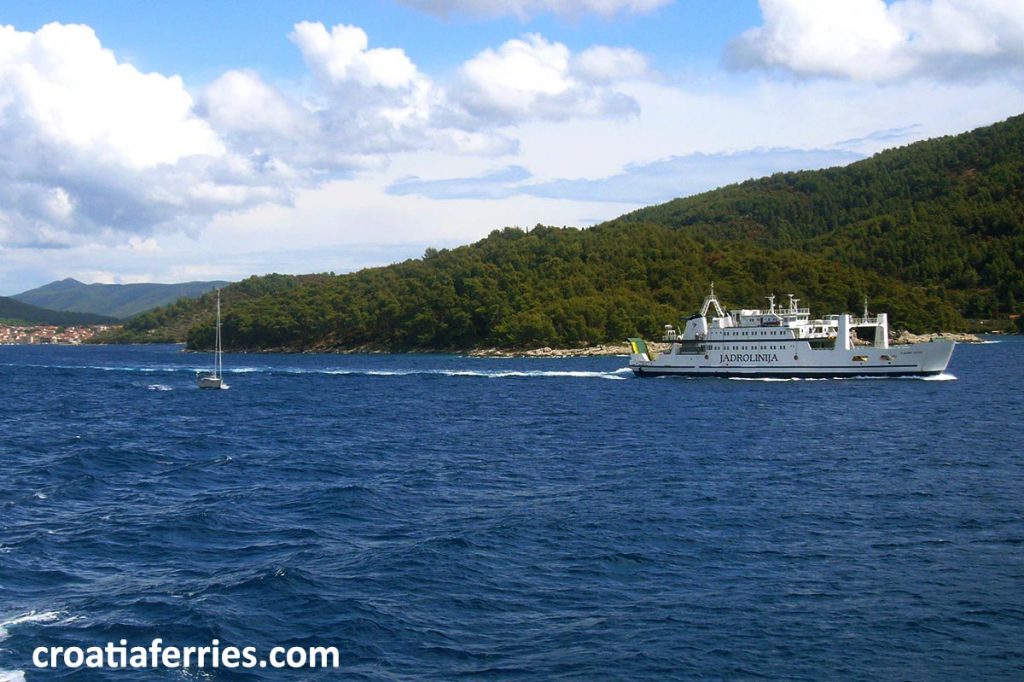
What documents are needed to travel on Jadrolinija’s ferries?
On all international ferry routes (Italy to Croatia) a valid passport or ID card and valid ticket is required
On all local ferry routes , a valid ferry ticket is required as well as a passport or ID card, as required by the country’s laws
How early to arrive for Jadrolinija ferry?
On all international ferry routes (Italy to Croatia) arrive at the port at least 2 hours prior to departure.
On all local ferry routes , try to be in the port at least 45 minutes prior to departure.
WIFI Connections
Do Jadrolinija ferries have WiFi? Yes, on some of the ferries there is a FREE wifi connection but it is not very reliable as part of the routes are in areas that have poor or very weak connectivity, so at the present, the best option is to rely on your own mobile data.
Air-Conditioning
All ferries owned by Jadrolinija are air-conditioned in the interior passenger spaces such as salons, bars, cafes, lounges, and cabins.
Ferry Cabins
On international ferry lines (Croatia to Italy) there are interior and exterior 2 to 4 bed/berth cabins. Some of them include washbasin/sink only while others also include ensuite WC, shower, radio & TV.
Outside (external) cabins have windows while inside (internal) cabins have no natural light. The onboard facilities depend on the ship/boat. The cheapest cabins are the smallest, inside ones and consist of bunk beds. Bed linens, towels, and soaps are provided in all cabins.
On the local (domestic) lines , there are no cabins available.
Reclining seats
On international ferry lines (Croatia to Italy) reclining (lounge) seats are available at additional cost. These seats are similar to seats in the airplane, (also called air or ‘avio’ seats), and are more comfortable than simple deck seats.
There is a non-smoking policy in all interior spaces of the ferry boat/ships. On outside decks, smoking is allowed.
Luggage allowance
Hand luggage up to 20 kg is carried free of charge
Multi-Trip Ticket Types
Unfortunately, there are no multiple journey tickets on Jadrolinija ferries. Each crossing has to be booked separately.
Jadrolinija’s home page + booking panel + all posts about Jadolinija
See below the latest ferry sailing schedules on Jadrolinija ferry routes:
- Ferries to Croatian Islands
- Ferries from the Croatian mainland
- Ferry schedules
- Croatian ferry ports
Ferry company Jadrolinija runs the following routes:
- Ferry route 51, connecting ferry port Zadar with Ancona
- Ferry route 53, connecting ferry port Split with Ancona , Stari Grad (Hvar)
- Ferry route 54, connecting ferry port Dubrovnik with Bari
- Ferry route 56, connecting ferry port Split with Bari
- Ferry route 101, connecting ferry port Rijeka with Split , Stari Grad (Hvar) , Korcula , Sobra (Mljet) , Dubrovnik
- Ferry route 310, connecting ferry port Mali Losinj with Srakane Vele , Unije , Susak
- Ferry route 332, connecting ferry port Valbiska with Merag (Cres)
- Ferry route 334, connecting ferry port Brestova with Porozina (Cres)
- Ferry route 335, connecting ferry port Prizna with Zigljen
- Ferry route 338, connecting ferry port Lopar with Valbiska
- Ferry route 401, connecting ferry port Zadar with Ist , Olib , Silba , Krijal , Mali Losinj
- Ferry route 409, connecting ferry port Preko with Zadar
- Ferry route 431, connecting ferry port Zadar with Preko
- Ferry route 432, connecting ferry port Tkon with Biograd na Moru
- Ferry route 433, connecting ferry port Zadar with Rivanj , Sestrunj , Zverinac , Molat , Ist
- Ferry route 434, connecting ferry port Brbinj with Zadar
- Ferry route 435, connecting ferry port Zadar with Brsanj , Rava , Mala Rava
- Ferry route 505, connecting ferry port Vodice with Sepurine , Prvic Luka , Zlarin , Sibenik
- Ferry route 532, connecting ferry port Sibenik with Zlarin , Kaprije , Obonjan , Zirje
- Ferry route 602, connecting ferry port Vis with Split
- Ferry route 604, connecting ferry port Ubli (Lastovo) with Vela Luka , Split
- Ferry route 631, connecting ferry port Split with Supetar (Brac)
- Ferry route 632, connecting ferry port Sucuraj (Hvar) with Drvenik
- Ferry route 633, connecting ferry port Trpanj with Ploce
- Ferry route 634, connecting ferry port Korcula (Domince) with Orebic
- Ferry route 635, connecting ferry port Stari Grad (Hvar) with Split
- Ferry route 636, connecting ferry port Rogac with Split
- Ferry route 638, connecting ferry port Sumartin (Brac) with Makarska
- Ferry route 807, connecting ferry port Sudurad with Lopud , Kolocep , Dubrovnik
- Ferry route 831, connecting ferry port Lopud with Sudurad , Dubrovnik , Kolocep
- Ferry route 832, connecting ferry port Sobra (Mljet) with Prapratno
- Ferry route 9308, connecting ferry port Mali Losinj with Susak , Unije , Martinscica (Cres) , Ilovik , Cres , Rijeka
- Ferry route 9309, connecting ferry port Novalja with Rab , Rijeka
- Ferry route 9403, connecting ferry port Ist with Zapuntel , Brgulje , Molat , Zadar
- Ferry route 9404, connecting ferry port Sestrunj with Zverinac , Bozava , Brbinj , Zadar , Rivanj
- Ferry route 9405, connecting ferry port Zadar with Mali Iz , Veli Iz , Mala Rava , Rava
- Ferry route 9602, connecting ferry port Vis with Milna (Brac) , Hvar , Split
- Ferry route 9603, connecting ferry port Jelsa (Hvar) with Bol (Brac) , Split
- Ferry route 9604, connecting ferry port Ubli (Lastovo) with Vela Luka , Hvar , Split
- Ferry route 9811, connecting ferry port Dubrovnik with Korcula , Hvar , Bol (Brac) , Split
- Ferry route 9825, connecting ferry port Split with Hvar
Ferry Schedules and Info
- Ferries from Italy to Croatia
- Ferries to / from Croatian Islands
- Ferries to / from Croatian Mainland
- Booking Ferries in Croatia
- Tips and Guides
- Ferries Map
- Island Hopping
- Ferry service status and weather forecast
- Ferry Photos
- Accommodation
Connect with us

- Privacy Policy
back to top
Croatia Ferries is © www.croatiaferries.com

- Dubrovnik ferry port
- Makarska ferry port
- Porec ferry port
- Prizna ferry port
- Pula ferry port
- Rijeka ferry port
- Rovinj ferry port
- Sibenik ferry port
- Split ferry port
- Stinica ferry port
- Umag ferry port
- Vodice ferry port
- Zadar ferry port
- Bol ferry port
- Brestova ferry port
- Hvar ferry port
- Jelsa ferry port
- Korcula ferry port
- Milna ferry port
- Preko ferry port
- Rogac ferry port
- Stari Grad ferry port
- Supetar ferry port
- Ubli ferry port
- Vis ferry port
- Vela Luka ferry port
- Island Brac
- Island Cres
- Island Dugi Otok
- Island Hvar
- Island Korcula
- Island Lastovo
- Island Losinj
- Island Mljet
- Island Pasman
- Island Solta
- Island Ugljan
- Jadrolinija
- TP line Dubrovnik
Adriatic lines
- G&V Line Zadar
- Rapska Plovidba
- Catamaran Line
- Krilo Shipping Company
- Venezia Lines
- Liberty Lines
- Gomo Viaggi
- Smaller Ferry Companies

Find your ferry
Split to dubrovnik ferry.
- Uncategorized
The ferry route from Split to Dubrovnik is currently operated by the ferry companies Jadrolinija, TP Line, and Krilo. Each of them has one or two departures, which is a catamaran/fast ferry for foot passengers only and operates in the summer season.
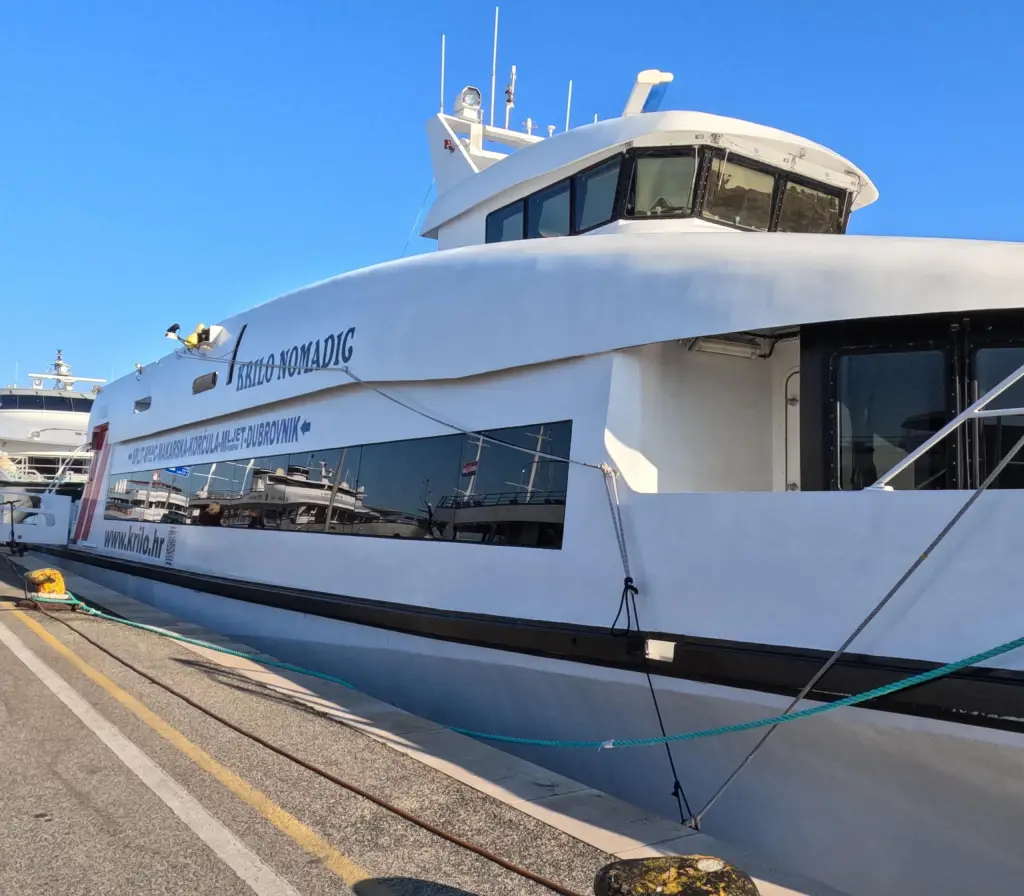
Here is the travel routes of some of the departures:
The Jadrolinija catamaran has the following sailing route: Split – Bol – Hvar – Korčula – Dubrovnik . The sailing time is around 6 hours.
The Krilo catamaran runs the following route: Split – Bol – Makarska – Korčula – Mljet – Dubrovnik and the travel time is about 5 hours.
The TP line ferry has the following sailing routes Split – Milna(Brac) – Hvar town – Korcula – Pomena(Mljet) – Dubrovnik, sailing time is about 5.5 hours .
As an alternative to the fast ferry (or the only option during the winter season), there are lots of buses from Split to Dubrovnik . The driving time of those is from 3 hours 30 minutes.
Split Dubrovnik , 2024-09-12
Map travel route Split - Dubrovnik
Watch our video about the split-dubrovnik ferry.
Ferry Split to Dubrovnik FAQs
Below I have tried to answer some of the typical question people ask when travelling from Split to Dubrovnik by ferry.
The sailing time is 5h with Krilo catamaran, and 6h with Jadrolinija catamaran.
Usually, the catamaran has a dedicated pier number from where they depart, but check out our information about the Split ferry port .
On catamarans operated by Jadrolinija, you can not bring your bike. However, on the Krilo catamaran, you can bring your bike, but you have to buy a ticket for it in advance, as there are only a few spaces.
If you travel with Jadrolinija you can see their rules here . If you travel with Krilo you can see the rules for pets here .
Unfortunately, you cannot reserve a seat upfront as seating is free. There is a seat for all passengers but the only option to catch a larger chunk of seats next to each other is to be first in line when you board the catamaran in Split.
Yes, all the catamarans have toilets.
Yes, each of the catamarans has a kiosk/bar, where you can buy, coffee, drinks, and snacks.
Each of the catamaran companies has different policies, for ticket amendment and cancellation, so you will have to check with them.
Traveling with a catamaran is more like traveling by train, you can walk around onboard, you have toilets and catering.
Yes, it is possible to do a day trip via ferry. You could take the morning catamaran from Split and be in Dubrovnik around noon. The departure back to Split is always around 16.30h, giving you a few hours to explore the city.
My personal tips for the Split to Dubrovnik trip
- Under my tips for the route Split to Hvar , i said being early or late for the boarding have different advantages. This is not the case for the route Split to Dubrovnik. I would 100% recommend, to be early at the port, so you can secure some good window seats on the boat, why is that?
- As I mentioned further up in the text, the ferries does not sail direct, but stops on Islands on the way, and having window seats, just gives you better access to the scenic views!
- Bring drinks and smuggle some food onboard, 5 to 6 hours on a boat is a long time, so you will need some refreshment, you can buy some onboard, but it is way cheaper to bring it.
Popular ferries from Split
Popular ferries from Dubrovnik
Facts about Ferry Split to Dubrovnik
| Shortest Travel Distance | 100 Nautical Miles (185 Km) |
| Fastest Sailing time | 4 hours 30 Minutes |
| Daily Ferries in Winter | From 0 departures Daily |
| Daily Ferries in Summer | Up to 5 daily departures |
| Average Ticket Price | €48 / $52 / £42 |
| Ferry Operators on this route | , , |
| Departure Location | |
| Non Stop Ferry | No, all ferries, have stops on the way |
Text and travel tips by Morten Smalby a travel Nomad living in Split Croatia
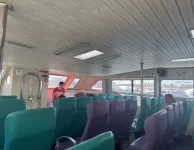
Split to Sutivan Ferry
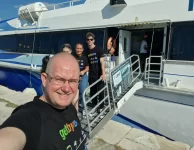
Morten Smalby
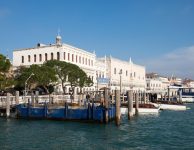
Novalja → Zadar
The fast ferry from Novalja on Pag Island Zadar is currently operated by a catamaran from the Jadrolinija ferry company. The catamaran operates once per day, departing from Novalja at 10:45 am pm every day except on Saturday when it departs at 11:45 am. T...
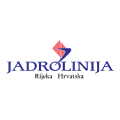
Jadrolinija: Ferries, Tickets & Info
- Ferry Tickets
- Ferry companies
- Jadrolinija
General info
Jadrolinija was established in 1947 in Rijeka and it is one of Croatia's oldest ferry companies . It operates domestic and international ferry connections between the Croatian coastline and Italy.
Jadrolinija ferry routes
Jadrolinija serves domestic and international ferry routes between Croatia and Italy. The domestic ferry routes connect the Croatian islands with the coastal cities of Rijeka, Zadar, Šibenik, Split, and Dubrovnik.
Some of the most popular ferry routes operated by Jadrolinija are:
- Ancona - Split
- Bari - Dubrovnik
- Split - Hvar
- Dubrovnik - Korčula
Some routes are active year-round, with increased frequency usually in the summer. However, most routes are operated seasonally .
Jadrolinija fleet & ships
Jadrolinija's fleet consists of 57 vessels : 12 high-speed ferries (catamarans), 4 conventional ferries, and 41 Ro/Ro vessels including the vessels Marko Polo and Dalmacija operating the international connections between Croatia and Italy.
Some other Jadrolinija ferries are Jelena, Sveti Juraj, Lubenice, Karolina, and Olbea.
Depending on your ferry route and the type of vessel, you can book a deck passenger ticket, an airplane-type seat , or opt for accommodation in a cabin . Keep in mind that you can only embark motor vehicles on conventional ships. Bicycles are only allowed on board catamarans on specific ferry routes.
Jadrolinija discounts & offers
The ferry company Jadrolinija offers special discounts for specific passenger categories including:
- People with disabilities
More specifically, on Jadrolinija ferries children up to 3 years travel for free , while children up to 12 years c an enjoy discount tickets of up to 75% , depending on the route. Keep in mind that no ticket is issued for children up to 1 year of age, and they are shown on their parents' booking.
Also, Jadrolinija offers a discount of around 20% on online bookings for return trip tickets .
By planning your trip on Ferryhopper, you can find all available offers and discounts, and book ferry tickets with Jadrolinija.
Jadrolinija special amenities & facilities
Jadrolinija ferries are modern with many facilities for travelers and offer great services ensuring a smooth and enjoyable journey. Most conventional ferries have bars, restaurants, duty-free shops and play areas for kids.
All Jadrolinija international ferries are equipped with elevators that lead from the car deck to the passenger deck. Some Jadrolinija vessels also have specially designated cabins for people with disabilities.
In addition, pets are welcome to travel with their owners free of charge . Make sure to bring the animal’s health booklet and any necessary pet supplies with you.
Small animals should be transported in kennels while dogs should be on a leash and wear a muzzle. Pets are only allowed on the outdoor deck with the exception of the catamarans in which small pets are also allowed in the lounge area. However, they should be in a portable pet carrier of up to 45x35x25 cm and up to 8 kg.
Find all Jadrolinija ferry timetables and connections, compare prices, and book your ferry tickets with ease!
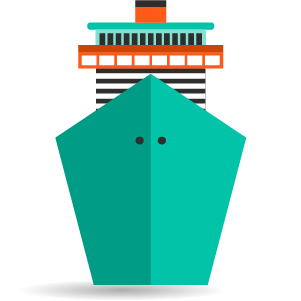
Popular ferry routes
Ferries - jadrolinija, terms & cancellation policy.

Jadrolinija
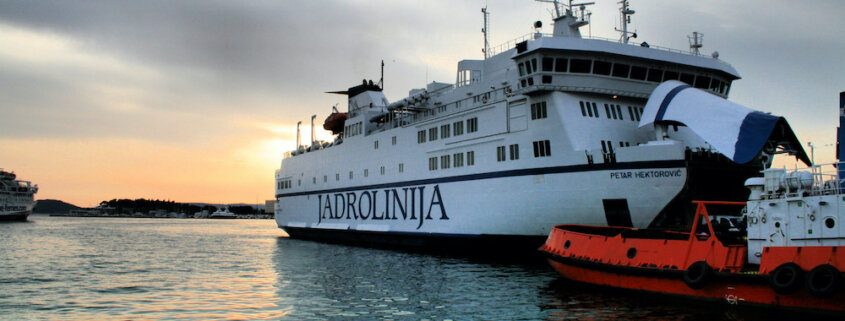
Jadrolinija is the main and largest ferry operator in Croatia, operating the vast majority of the car ferry and catamaran routes in the country. Jadrolinija also operates a number of international ferries to Croatia (although these only exist from Italy to Croatia!). If you’re planning on travelling down the coast or visiting any of the islands in Croatia , you will very likely be utilising Jadrolinija’s services!

History of Jadrolinija
Jadrolinija was founded on 20th January 1947 in Rijeka , the northern Croatian coastal city, which is still its base today. However, the company can trace its origins to as far back as 1872 to a shipping company that started operating sailings from Rijeka to Senj (about 65km south along the coast), stopping at smaller towns such as Crikvenica in between.
The establishment of other shipping companies and various mergers over the subsequent decades (not to mention the fall of the Austro-Hungarian Empire) eventually led to a company named Jadranska plovidba being formed in 1922. This company had some 70 ships on passenger and goods lines, and sailed as far as Albania, Greece and further afield in the Eastern Mediterranean.
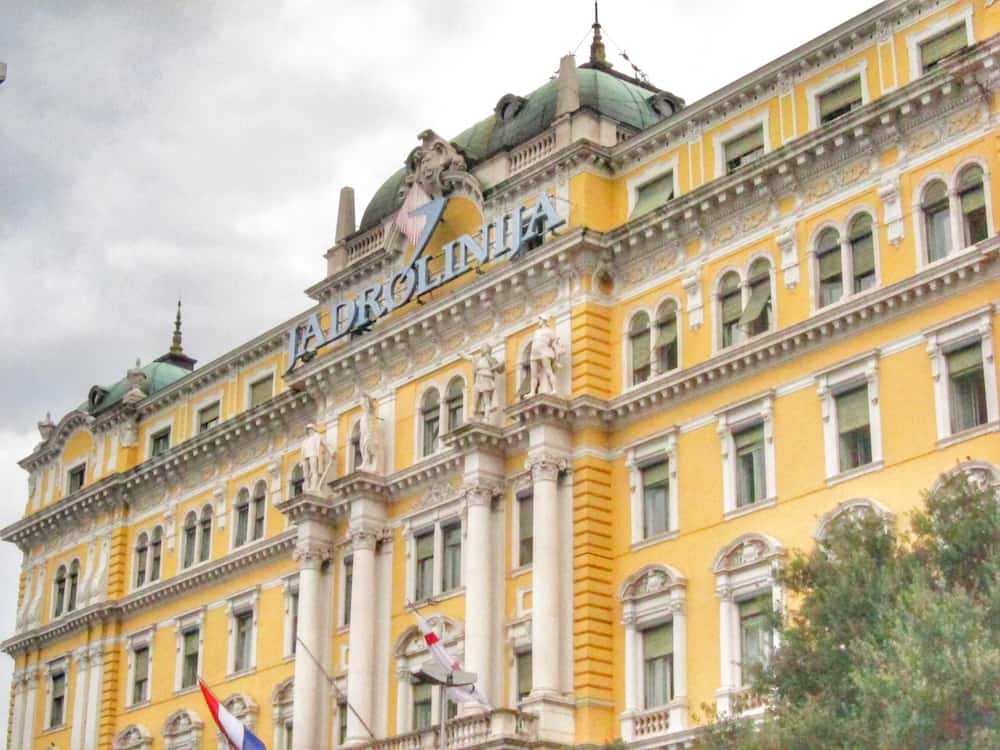
Following World War II, in 1947, the new company Jadranska linijska plovidba was formed. At that time, however, it inherited many of the older ships from the previous company, some of which were built in the time of the Austro-Hungarian Empire.
From the 1950s onwards, the company acquired new ships and it started operating its first ferry in 1963.
The Simplon Postcards website has a fascinating gallery of Jadrolinija’s boats , including those operating today going all the way back to their fleet built pre-1911!
Jadrolinija’s Boats and Passengers
The company operates 3 large car ferries (with cabins) on international routes, 37 smaller car ferries, 10 catamarans and 4 more traditional ships.
It transports over 12 million people and 3 million cars annually.
Jadrolinija’s International Routes
Italy to croatia.
The company runs three routes connecting Italy and Croatia – Ancona to Zadar , Ancona to Split , Bari to Split and Bari to Dubrov n ik . The most frequent of these three routes is Ancona to Split, which is also the only Italy-Croatia route to operate year-round. In peak season – usually July and August – this route also stops at Stari Grad on the island of Hvar .
Italy to Montenegro
Jadrolinija has previously run a route connecting Bari to Bar in Montenegro, but this is not running at present.
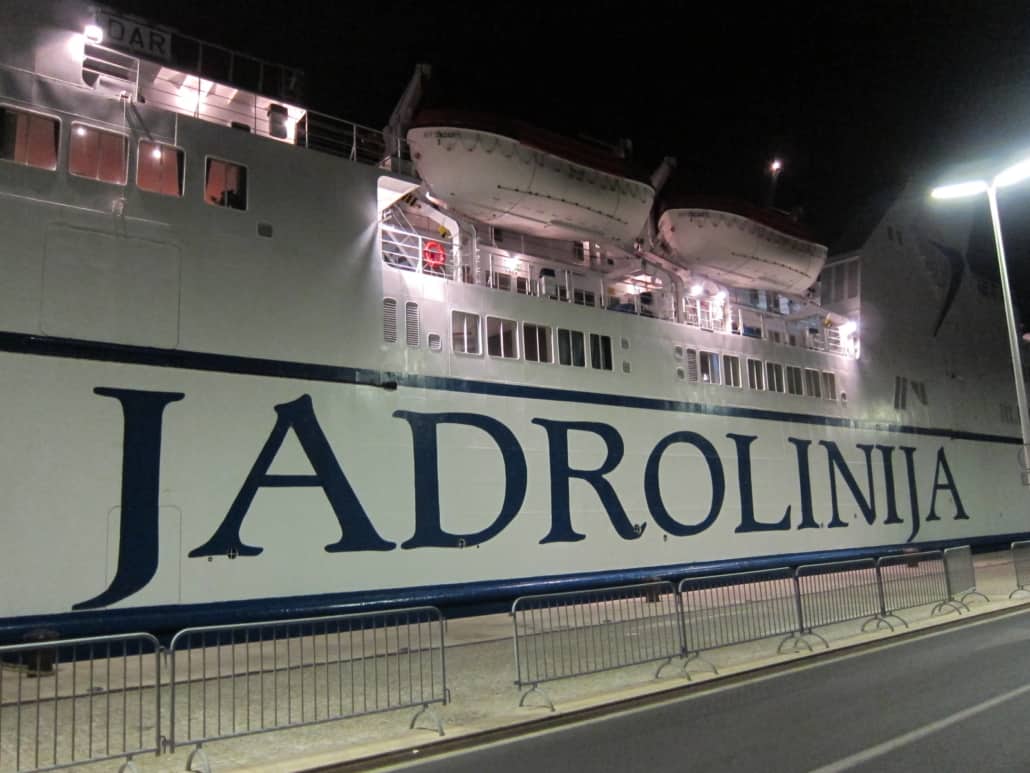
Jadrolinija’s Domestic Routes
Their routes are separated into several ‘districts’ of the Croatian coastline – sailings running in the Rijeka District, Zadar District, Sibenik District, Split District and Dubrovnik District.
Rijeka District
Lines in this region are:
- Mali Lošinj – Srakane Vele – Unije – Susak – Mali Lošinj – passenger ship
- Valbiska (Krk) – Merag (Cres) – car ferry
- Brestova – Porozina (Cres) – car ferry
- Prizna – Zigljen (Pag) – car ferry
- Valbiska (Krk) – Lopar (Rab) – car ferry
- Rijeka – Rab – Novalja (Pag) – catamaran
- Mali Losinj – Ilovik – Susak – Unije – Martinscica – Cres – Rijeka – catamaran
Zadar District
- Zadar Gazenica – Ist – Olib – Silba – Premuda – Mali Losinj – car ferry
- Zadar – Preko – passenger ship
- Zadar Gazenica – Osljak – Preko (Ugljan) – car ferry
- Biograd – Tkon (Pasman) – car ferry
- Zadar Gazenica – Rivanj – Sestrunj – Zverinac – Molat – Ist – car ferry
- Zadar Gazenica – Brbinj (Dugi otok) – car ferry
- Zadar Gazenica – Brsanj (Iz) – Rava – Mala Rava – car ferry
- Zadar – Molat – Brgulje – Zapuntel – Ist – catamaran
- Zadar – Rivanj – Sestrunj – Zverinac – Bozava – Brbinj – catamaran
- Zadar – Mali Iz- Veli Iz – Mala Rava- Rava – catamaran
Sibenik District
- Sibenik – Zlarin – Prvic Luka – Sepurine – Vodice – catamaran
- Sibenik – Zlarin – Obonjan – Kaprije – Žirje – car ferry
Split District
- Split – Vis – car ferry
- Split – Supetar (Brac) – car ferry
- Split – Stari Grad (Hvar) – car ferry
- Drvenik – Sucuraj (Hvar) – car ferry
- Ploce – Trpanj (Peljesac) – car ferry
- Split – Rogac (Solta) – car ferry
- Sumartin (Brac) – Makarska – car ferry
- Orebic – Domince (Korcula) – car ferry
- Split – Vela Luka (Korcula) – Ubli (Lastovo) – car ferry
- Trogir (Soline) – Drvenik Mali – Drvenik Veli – car ferry
- Split – Bol (Brac) – Jelsa (Hvar) – catamaran
- Split – Hvar – Vela Luka (Korcula) – Ubli (Lastovo) – catamaran
- Split – Milna (Brac) – Hvar – Vis – catamaran
- Split – Hvar – catamaran
Dubrovnik District
- Dubrovnik – Kolocep – Lopud – Sudjuradj (Sipan) – passenger ship
- Dubrovnik – Lopud – Sudjuradj (Sipan) – car ferry
- Prapratno (Peljesac) – Sobra (Mljet) – car ferry
- Dubrovnik – Korcula – Hvar – Bol – Split – catamaran
Jadrolinija Tickets
Jadrolinija does now offer online booking for their catamarans and ferries on their website . You can also buy tickets, in person, at one of the numerous sales points at ports in Croatia.
Almost all of Jadrolinija’s routes have different prices for low season (1st January to end of May and early October to 31st December) and high season (June to September inclusive).
All details on Jadrolinija’s routes and ticket prices can be found on the Jadrolinija website.
Additional information on travelling by ferry in Croatia can be found on our Ferries in Croatia , Ferry and catamaran prices in Croatia and Croatia Ferries Map pages. Or if you’re travelling to Croatia, take a look at our Getting to Croatia by Ferry and Ferries to Croatia pages.

More on Visit Croatia
About Visit Croatia
Contact Visit Croatia
Buy us a coffee!
Cookie Policy
Privacy Policy
Updated daily
New & Updated on Visit Croatia
Sightseeing in Pula A Wellness Break in Croatia Stari Grad Obonjan Bol Porec Two Days in Zagreb Slano How to do Croatia on a Budget Two Days in Split Nin Campsites in Croatia City Break in Croatia Two Days in Pula Family Holidays in Croatia 15 Things You May Not Know About Croatia Two Days in Zadar Koprivnica
Useful information on Croatia
Money in Croatia Visa Requirements for Croatia Buses in Croatia Ferries in Croatia Top Ten Destinations in Croatia Map of Croatia About Croatia
Jadrolinija
- Music & Dance
- Architecture
- National Holidays
- Why Croatia?
- From Slovenia
- Accommodation
- Best of Croatia
- Dalmatian Highlights
- Island Hopping
- Istrian Archaeology
- Parks & Heritage Sites
- Mistakes to Avoid
- Travel Insurance
- Border Formalities
- Electricity
- Opening Hours
- Plitvice Lakes
- Kvarner Coast
- Best Islands
- National Parks
- Nature Parks
- Heritage Sites
- Horse Riding
- Rock Climbing
- Windsurfing
- Solo Travel
- Family Travel
- LGTBQ Travel
- Romantic Spots
- Ask a question
- Consultations
- Advertising
- Privacy Policy
- Search Site
- Find Hotels
Jadrolinija is Croatia's national ferry company. Founded in 1947 to connect Croatia's islands with the mainland, Jadrolinija currently operates a fleet of 56 ships including 37 local ferries, 8 catamarans, 1 hydrobus and 5 regular ships. There are up to 500 daily departures in the summer, with about half that off-season.
Jadrolinija Schedules
Jadrolinija schedules are pubished at the beginning of the year but there are often changes throughout the year. The summer schedule runs from the last few days of May or beginning of June to the last few days of September or beginning of October. There are often additional departures in July and August and sometimes in June and September as well.
The winter schedule starts at the end of September and runs to the end of May and includes the special schedules for the holiday period. It's not unusual for one route to have three and sometimes four different schedules!
Jadrolinija Prices
Jadrolinija has three price categories: low season, high season and weekend prices for international routes. There is now a substantial penalty for weekend travel from Ancona to Split and Zadar and Bari to Dubrovnik. On domestic services there is no weekend penalty.
There's a 50% reduction for children from 3 to 12 (children under 3 travel free) and there's a 20% reduction on the return portion of a round-trip ticket.
Booking Jadrolinija Ferries
All local and international car ferries and local catamarans can now be booked online. Click here for online Jadrolinija booking. There are Jadrolinija offices in all coastal and island towns that have a ferry connection. In other places, tickets are handled by local travel agencies. See more about booking Croatia ferries.
It's important to note that purchasing a ticket for a car ferry does not reserve a place for your car. You must queue up anywhere from one to three hours before boarding in order to be assured of a place. Any Jadrolinija office will inform you of the advised waiting time depending on the departure.
Jadrolinija On-board Services
With such a vast fleet, it's logical that on-board services vary from very basic to quite comfortable if not luxurious. The newer the ship, the more comfortable and modern the on-board experience. Generally, the most comfortable experience is on the international routes. The most heavily travelled domestic routes usually get the best ships. Get more details about Jadrolinija on-board.
|
|
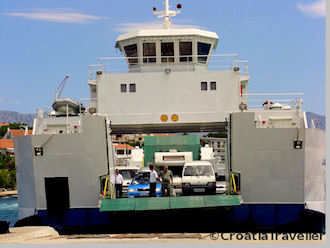
Join the Croatia Traveller Group
Recommended Experiences
Questions? Comments?
Back to Top
©CroatiaTraveller 2005-2024 All rights reserved
Choose another ship

The catamaran was built in 2018 in Singapore for the needs of our fleet. It is characterized by the most modern water purification system, the most modern navigation system, and is fully adapted to people with disabilities, so we can say that it is one of the best boats of its type in the Adriatic.

Characteristics
Passenger capacity
Jadrolinija
- Riva 16, HR-51000 Rijeka
- Follow the latest news via RSS feed
072 30 33 37
Call price from fixed network is 0,03 EUR/min

- Living In Croatia
- Croatian Recipes
- Balkan Recipes

Home > 2024 Ferry From Split To Dubrovnik – Tickets & Times
2024 Ferry From Split To Dubrovnik – Tickets & Times

Written by our local expert Mate
Mate is Croatian and owns a transport company in the Balkans, he has visited over 30 countries. He is an expert on all things transportation as well as food and wine.
Are you planning to explore Croatia’s stunning Dalmatian Coast? If you’re considering the journey from Split to Dubrovnik, let me share a gem of a travel option: the ferry trip.
Having taken this route myself numerous times over the past 20 years, I can vouch for its appeal. It’s admittedly slower than driving, but trust me, it’s worth the pace.
The ferry offers a relaxing, comfortable trip that is also a scenic way to experience the Adriatic Sea. Read on for the ferry timetables, average price, popular routes, and more.
Here’s what you need to know to make your ferry from Dubrovnik to Split the total highlight of your Croatian trip.
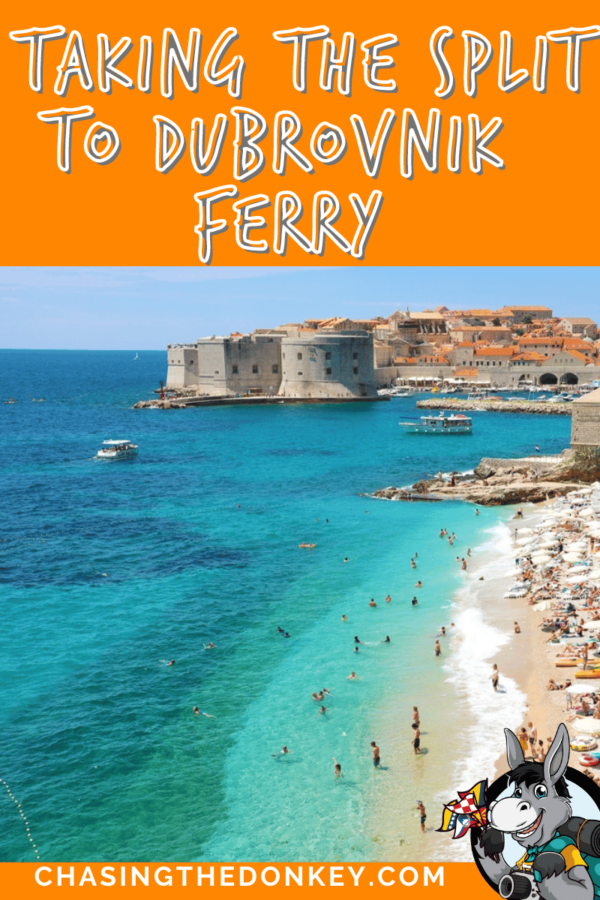
- Ferry Travel Time : 4-6 hours, depending on stops and operators
- Best Way to Book: directly through the ferry company websites or a site like this well in advance in high season; no need in low season
- Ferry Operators: Jadrolinija, Krilo & Kapetan Luka
- Reservations: recommended during peak season for guaranteed spots
Ferries in Croatia are a popular way to hop between coastal cities and islands. They’re like big buses on water, carrying people, cars, and sometimes cargo. It’s a practical and scenic way to travel.
For your Split to Dubrovnik ferry, you can choose from several operators, including Jadrolinija, Krilo, and Kapetan Luka. You can book directly on their websites or use aggregator sites like this for convenience.
Most routes stop at Milna (Brac Island) and Hvar Town (Hvar Island) before reaching Dubrovnik. Some extend to Korčula Island. The journey typically takes between 4 and 6 hours, depending on the route.
Jadrolinija offers traditional ships, usually slower and more budget-friendly. Krilo and Kapetan Luka operate fast catamarans with amenities geared toward sightseeing and comfort.
We recommend you book your ferries with Ferryhopper in advance here.
Skip Ahead To My Advice Here!
Split To Dubrovnik & Dubrovnik To Split Ferry Details

- Ferries run 1 or 2 times daily, starting in the morning until mid-afternoon. Pick a time that fits your schedule and allows for daytime exploration
- The ferry services between Split and Dubrovnik, as well as Dubrovnik to Split, are operated by Jadrolinija, TP Line, and Krilo
- These ferries are specifically catamarans and are only available if you are a foot passenger – no cars allowed
- They operate during the summer season only
- In the winter season, you can fly, take a bus ride, or book a private transfer to travel between the two cities
- You can’t use these ferries as a day trip – as you will have no sightseeing time
- Ferry ticket prices vary; budget 45 euros per person each way
- Ferries are dependent on the weather conditions
Brands We Use And Trust
Split to dubrovnik ferry schedule.
- Ferry Route: Split – Bol – Hvar – Korčula – Dubrovnik
- Sailing Time: About 6 hours
- Ferry Route: Split – Bol – Makarska – Korčula – Mljet – Dubrovnik
- Journey Time: About 5 hours
- Ferry Route: Split – Milna (Brač) – Hvar town – Korčula – Pomena (Mljet) – Dubrovnik
- Sailing Time: About 5.5 hours
- Ferry Route: Split – Brač (Milna) – Hvar – Korčula – Dubrovnik
- Saling Time: About 5 hours
Dubrovnik To Split Ferry Schedule

Jadrolinija and Krilo Catamarans
- Jadrolinija Ferries : Dubrovnik – Korčula town – Hvar town – Bol (Brac) – Split
- Krilo Ferries : Dubrovnik – Sobra (Mljet) – Korcula old town – Makarska – Bol (Brac) – Split
- Sailing Time : About 5 hours (Krilo) and 6 hours (Jadrolinija)
- Departure Time : 15:15 from Dubrovnik
- Arrival Time : 20:30 in Split
- Operational Period : From April to October, daily service
- Price : Approximately 45 EUR per passenger
TP Line Ferry
- Ferry Route : Split – Milna (Brač) – Hvar town – Korčula – Pomena (Mljet) – Dubrovnik
- Sailing Time : About 5.5 hours
- Departure Time : 09:15 from Split
- Arrival Time : 14:35 in Dubrovnik
- Operational Period : From April to October, daily departures
TP Line Catamaran
- Ferry Route : Split – Brač (Milna) – Hvar – Korčula – Dubrovnik
- Sailing Time : About 5 hours
- Arrival Time : 13:20 in Dubrovnik
- Operational Period : From June to September, daily departures
- Price : Approximately 48 EUR per passenger
Please note that these schedules are subject to change, and it’s advisable to confirm the exact timings and availability closer to your travel date.
Travel In Off-Peak Season
The ferry services between Split and Dubrovnik, operated by Jadrolinija, TP Line, and Krilo, are specifically scheduled for the summer months, running from May to September.
Outside of this period, from October to April, these ferry services are not operational.
If you need to travel between Split and Dubrovnik during the off-season, you’ll need to consider alternative means of transportation such as bus, car, or flight. Always check with the ferry companies or local travel information for the most current schedules and available services.
Ferry Booking Tips
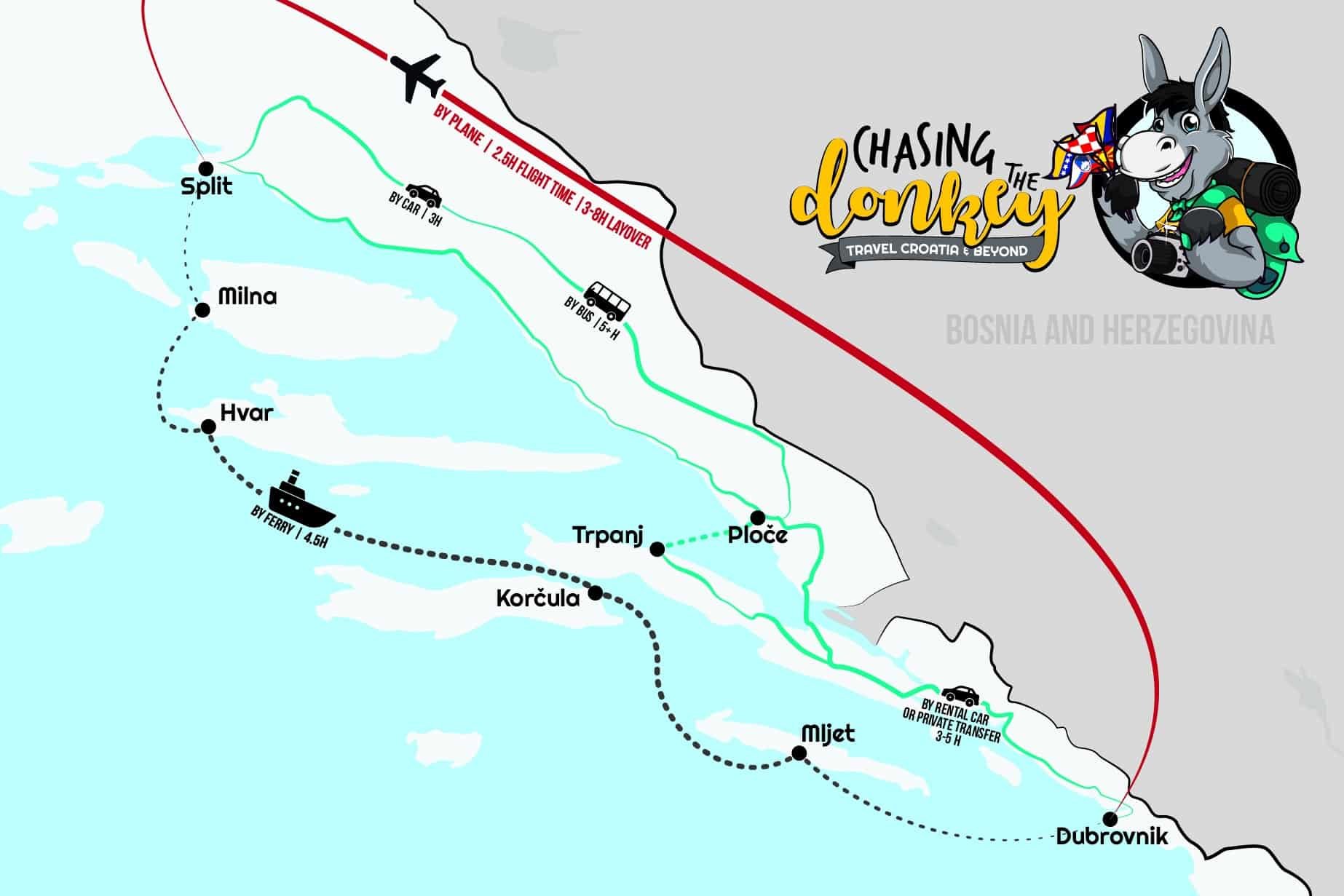
During summer, it’s wise to book in advance. Have your printed tickets or a mobile QR code ready for boarding, and arrive about 30 minutes before departure.
The ferry ride itself is part of the adventure. You’ll get unique views of the coast and islands, a chance to relax and move around on the ferry, and the opportunity to briefly explore island ports.
Split and Dubrovnik, your start and end points, are cities rich in history. Split’s Diocletian Palace and Dubrovnik’s impressive city walls are just a couple of the historical highlights. Hvar Town, a stop along the way, offers a glimpse into its Venetian-influenced past.
Enjoy the scenic coastal views, relax in the lounges, and maybe spot some dolphins! Whether you’re sunbathing, reading, or just gazing at the sea, the ferry offers a peaceful and memorable experience.
- Is Dubrovnik Worth Visiting?
How long is the ferry ride from Split to Dubrovnik?
The ferry ride duration is typically 4-6 hours, depending on stops and the operator.
What is the best way to book ferry tickets?
Booking online directly through the ferry company website well in advance ensures the best fares and availability.
Which ferry operators run between Split and Dubrovnik?
Popular companies include Jadrolinija, Krilo, and Kapetan Luka. Each offers different routes and amenities.
What activities are there to do during the ferry journey?
Relaxing in lounges, sunbathing on open decks, reading, people-watching, and enjoying refreshments are top ways to pass the time.
Should I make a reservation for the ferry?
Yes, reservations are highly recommended during peak season to guarantee a spot, especially if you have an onward travel connection.
What are the border crossing procedures for the ferry journey?
When taking the ferry, there is no border crossing.
Can I catch a ferry directly from Dubrovnik Airport to Split?
There’s no direct ferry from any airport to Split. You’ll need to travel to the Dubrovnik ferry port, which is well-connected by bus or private car transfers.
Is the ferry route between Split and Dubrovnik a UNESCO World Heritage Site?
While the ferry route itself isn’t a UNESCO site, it passes near several, including the historic centers of Split and Dubrovnik.
How do private car transfers compare to ferry travel between Split and Dubrovnik?
Private car transfers offer a more personalized and direct route, often using the scenic Peljesac Bridge, but they miss the unique nautical experience of the ferry.
Is renting a car a better option than taking the ferry?
Car rentals provide more flexibility and can be faster, but you will need to pass the border crossing at the Neum Corridor.
Are there any shortcuts or less-known routes to travel between Split and Dubrovnik?
The most direct route is by road, but the ferry provides a more scenic journey.
What’s the price range for a one-way ticket on the ferry from Split to Dubrovnik?
Prices vary depending on the ferry company, season, and type of service.
Taking the ferry between Split and Dubrovnik is more than just a means of getting from point A to point B. It’s an integral part of the Croatian coastal experience, blending travel with discovery. So, when you’re mapping out your Croatia adventure, definitely consider this ferry journey as a key part of your itinerary. Happy travels!
- Ferry From Croatia To Greece
- Ferry Options In Croatia
- Ancona To Split Ferry Tickets
- Best Beaches In Split
- Best Boat Tours From Split
- Ferry From Split To Bol
- Best Ways To Travel From Split To Dubrovnik
- Split Vs. Dubrovnik Comparison Guide
- Private Transfer From Split To Dubrovnik
- How Many Days In Dubrovnik Is Enough?
Comments (2)
Thanks for this very well written, clear and helpful information. We were thinking of doing a small ship cruise along the coast but this sounds like a much cheaper option to see the coastline of Croatia. Could you please explain: 1. Is this 45 EUR for a one way or return ticket? 2. Do we have to stay on board for the whole ferry ride or is it possible to get off at different places and get back on a later ferry? Or Get off and stay overnight somewhere, to do sightseeing before continuing the journey the next day? Any other advice you can give would be very much appreciated. Thanks very much.
As far as I know the ferry ticket is for the day of travel only, and does not allow you to break up the journey. But, ask the company as they may allow it.
Leave a Reply Cancel reply
Your email address will not be published. Required fields are marked *
Save my name, email, and website in this browser for the next time I comment.
This site uses Akismet to reduce spam. Learn how your comment data is processed .
Move This Adventure To Your Inbox & Get An Instant Freebie
Subscribe To Unlock Your FREE Customizable Travel Packing List & All Our Best Tips!
Unlock Your FREE Customizable Travel Packing List!
Subscribe Now For Instant Access To Stress-Free Packing
Jump to navigation

Fast ferry (catamaran) Split - Hvar
Date_range sailing timetable 2024.
- Place of departure Time of departure Place of arrival Time of arrival
- ↓ Direction Split → Hvar (centar) (Hvar) ↓ (⇄)
- ↓ Direction Hvar (centar) (Hvar) → Split ↓ (⇄)
- Hvar (centar) (Hvar) 21:00 Split 22:05
- Hvar (centar) (Hvar) 17:30 Split 18:35
Prices 2024
- Regular passenger ticket Hvar (centar) (Hvar) → Split 25,00 € 188,36 kn High-season price (26. 04. 2024. - 19. 10. 2024.)
- Children aged 3-12 Hvar (centar) (Hvar) → Split 25,00 € 188,36 kn High-season price (26. 04. 2024. - 19. 10. 2024.)
- Regular passenger ticket Split → Hvar (centar) (Hvar) 25,00 € 188,36 kn High-season price (26. 04. 2024. - 19. 10. 2024.)
- Children aged 3-12 Split → Hvar (centar) (Hvar) 25,00 € 188,36 kn High-season price (26. 04. 2024. - 19. 10. 2024.)
All ferry lines
- Fast ferry (catamaran) Dubrovnik - Korčula - Hvar - Bol (Brač) - Split
- Fast ferry (catamaran) Dubrovnik - Korčula - Ubli (Lastovo)
- Fast ferry (catamaran) Dubrovnik - Pomena (Mljet) - Korčula
- Fast ferry (catamaran) Dubrovnik - Šipanska Luka (Šipan) - Sobra (Mljet) - Polače (Mljet) - Korčula - Ubli (Lastovo)
- Fast ferry (catamaran) Pula - Rovinj - Poreč - Umag - Venice
- Fast ferry (catamaran) Pula - Unije - Susak - Mali Lošinj - Ilovik - Silba - Zadar
- Fast ferry (catamaran) Rijeka - Cres - Martinšćica (Cres) - Unije - Susak - Ilovik - Mali Lošinj
- Fast ferry (catamaran) Rijeka - Krk - Rab - Silba - Zadar
- Fast ferry (catamaran) Rijeka - Rab - Novalja (Pag)
- Fast ferry (catamaran) Rijeka - Rab - Veli Lošinj - Novalja (Pag) - Zadar
- Fast ferry (catamaran) Šibenik - Kaprije - Žirje
- Fast ferry (catamaran) Split - Bol (Brač) - Hvar - Resnik (Split airport / Kaštela)
- Fast ferry (catamaran) Split - Bol (Brač) - Jelsa (Hvar)
- Fast ferry (catamaran) Split - Bol (Brač) - Makarska - Korčula - Pomena (Mljet) - Dubrovnik
- Fast ferry (catamaran) Split - Hvar
- Fast ferry (catamaran) Split - Hvar (Vira)
- Fast ferry (catamaran) Split - Hvar - Korčula
- Fast ferry (catamaran) Split - Hvar - Prigradica (Korčula) - Korčula
- Fast ferry (catamaran) Split - Hvar - Vela Luka (Korčula) - Ubli (Lastovo)
- Fast ferry (catamaran) Split - Milna (Brač) - Hvar - Korčula - Dubrovnik
- Fast ferry (catamaran) Split - Milna (Brač) - Hvar - Korčula - Pomena (Mljet) - Dubrovnik
- Fast ferry (catamaran) Split - Milna (Brač) - Hvar - Vis
- Fast ferry (catamaran) Split - Resnik (Split airport / Kaštela)
- Fast ferry (catamaran) Split - Rogač (Šolta) - Sutivan (Brač) - Milna (Brač)
- Fast ferry (catamaran) Split - Sutivan (Brač)
- Fast ferry (catamaran) Split - Vis - Hvar - Bol (Brač) - Makarska
- Fast ferry (catamaran) Stari Grad (Hvar) - Hvar - Vela Luka (Korčula) - Pescara
- Fast ferry (catamaran) Zadar - Božava (Dugi otok) - Silba
- Fast ferry (catamaran) Zadar - Mali Iž - Veli Iž - Mala Rava - Rava
- Fast ferry (catamaran) Zadar - Molat - Brgulje (Molat) - Zapuntel (Molat) - Široka (Ist)
- Fast ferry (catamaran) Zadar - Premuda - Silba - Olib
- Fast ferry (catamaran) Zadar - Rivanj - Sestrunj - Zverinac - Božava (Dugi otok) - Brbinj (Dugi otok)
- Fast ferry (catamaran) Zadar - Sali (Dugi otok) - Zaglav (Dugi otok) - Bršanj (Iž)
- Passenger & vehicle (car) ferry Bar - Bari
- Passenger & vehicle (car) ferry Biograd - Tkon (Pašman)
- Passenger & vehicle (car) ferry Brestova - Porozina (Cres)
- Passenger & vehicle (car) ferry Drvenik - Dominče (Korčula)
- Passenger & vehicle (car) ferry Drvenik - Sućuraj (Hvar)
- Passenger & vehicle (car) ferry Dubrovnik - Bari
- Passenger & vehicle (car) ferry Dubrovnik - Koločep - Lopud - Suđurađ (Šipan)
- Passenger & vehicle (car) ferry Lopar (Rab) - Valbiska (Krk)
- Passenger & vehicle (car) ferry Makarska - Sumartin (Brač)
- Passenger & vehicle (car) ferry Orebić (Pelješac) - Dominče (Korčula)
- Passenger & vehicle (car) ferry Ploče - Trpanj (Pelješac)
- Passenger & vehicle (car) ferry Prapratno (Pelješac) - Sobra (Mljet)
- Passenger & vehicle (car) ferry Prizna - Žigljen (Pag)
- Passenger & vehicle (car) ferry Rijeka - Split - Stari Grad (Hvar) - Korčula - Sobra (Mljet) - Dubrovnik
- Passenger & vehicle (car) ferry Šibenik - Zlarin - Kaprije - Žirje
- Passenger & vehicle (car) ferry Split - Ancona
- Passenger & vehicle (car) ferry Split - Bari
- Passenger & vehicle (car) ferry Split - Rogač (Šolta)
- Passenger & vehicle (car) ferry Split - Stari Grad (Hvar)
- Passenger & vehicle (car) ferry Split - Supetar (Brač)
- Passenger & vehicle (car) ferry Split - Vela Luka (Korčula) - Ubli (Lastovo)
- Passenger & vehicle (car) ferry Split - Vis
- Passenger & vehicle (car) ferry Stinica - Mišnjak (Rab)
- Passenger & vehicle (car) ferry Trogir - Drvenik Mali - Drvenik Veli
- Passenger & vehicle (car) ferry Valbiska (Krk) - Merag (Cres)
- Passenger & vehicle (car) ferry Zadar - Ancona
- Passenger & vehicle (car) ferry Zadar - Brbinj (Dugi otok)
- Passenger & vehicle (car) ferry Zadar - Bršanj (Iž) - Rava - Mala Rava
- Passenger & vehicle (car) ferry Zadar - Kosirača (Ist) - Olib - Silba - Krijal (Premuda) - Mali Lošinj
- Passenger & vehicle (car) ferry Zadar - Ošljak - Preko (Ugljan)
- Passenger & vehicle (car) ferry Zadar - Rivanj - Sestrunj - Zverinac - Molat - Zapuntel (Molat) - Kosirača (Ist)
- Passenger ferry Biograd - Pakoštane - Vrgada
- Passenger ferry Biograd - Vrgada
- Passenger ferry Brodarica - Krapanj
- Passenger ferry Dubrovnik - Koločep - Lopud - Suđurađ (Šipan)
- Passenger ferry Ilovik - Mrtvaška (Lošinj)
- Passenger ferry Komiža (Vis) - Mezuporat (Biševo) - Salbunara (Biševo) - Porat (Biševo)
- Passenger ferry Mali Lošinj - Vele Srakane - Unije - Susak
- Passenger ferry Orebić (Pelješac) - Korčula
- Passenger ferry Šibenik - Zlarin - Prvić Luka - Prvić Šepurine - Vodice
- Passenger ferry Split - Slatine (Čiovo) - Trogir
- Passenger ferry Zadar - Mali Iž - Veli Iž - Mala Rava - Rava
- Passenger ferry Zadar - Preko (Ugljan)
- Passenger ferry Zadar - Sali (Dugi otok) - Zaglav (Dugi otok)

Share ×

Scan the QR code and open PeakVisor on your phone
❤ Wishlist ×
See all region register, peakvisor app, sverdlovsk oblast.
The Sverdlovsk Region territorially covers practically the entire Middle Urals and part of the Northern Urals . The region is usually associated with the Urals in general, and the city of Yekaterinburg, its administrative centre, is called the capital of the Urals . This city is also the centre of the Urals Federal District.
Flora and Fauna
Water resources, landmarks and tourism, konzhakov stone, serebryansky kamen (stone), denezhkin stone & the kvarkush range, kachkanar mountain, the peter the gronsky aka petrogrom rocks, the devil's fortress, the seven brothers rocks, mount bunar, the urals mars, reserves, national and natural parks, picturesque rivers, the revun rapids, zoo nurseries, major cities, yekaterinburg.
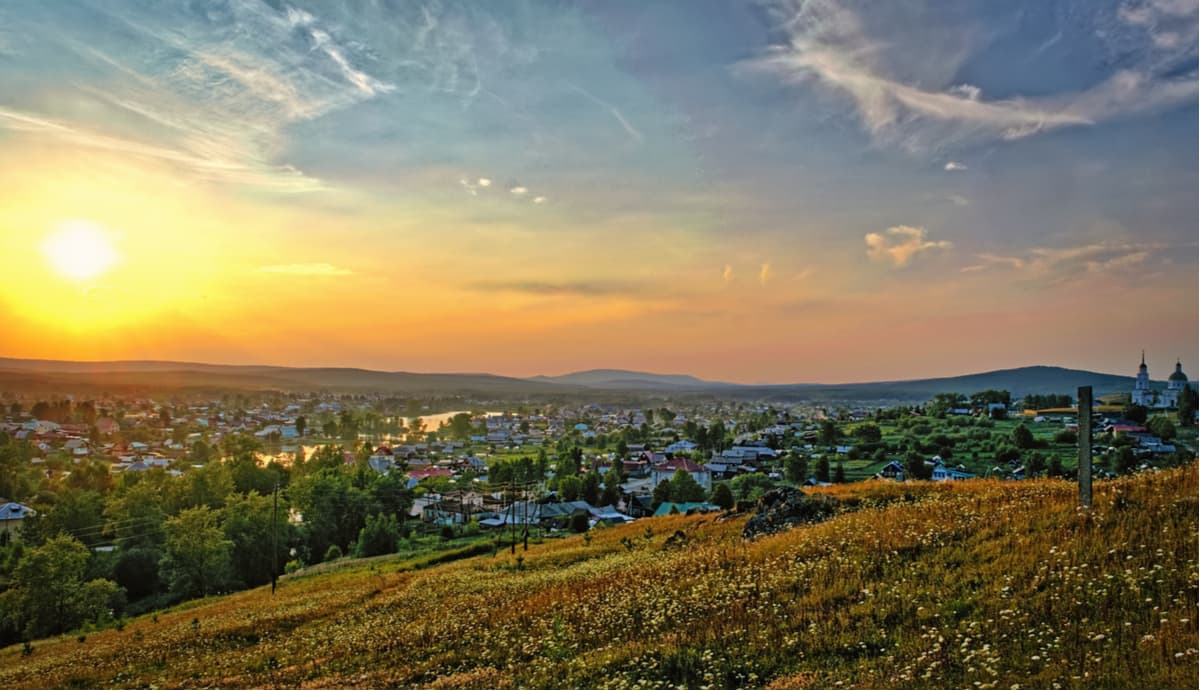
In earlier times, the region was part of the Siberian province, then part of the Trans-Ural region of the Perm province of the Russian Empire. As an administrative unit, the Sverdlovsk Region was separated from the Urals Region in 1934 and finally appeared on the maps as an independent entity. It received its name from the regional centre – the city of Sverdlovsk, which is actually Yekaterinburg, but the city was renamed in the Soviet times to commemorate the revolutionary Yakov Sverdlov. After the collapse of the Soviet Union, the city was given back its historical name – Yekaterinburg, but the region was not renamed, thus the discrepancy. The same story happened with Saint Petersburg and Leningradskaya Region.
The Sverdlovsk Region borders the Komi Republic and the Khanty-Mansi Autonomous Region in the north, the Tyumen Region in the east, the Kurgan and Chelyabinsk Regions in the south, the Republic of Bashkortostan and the Perm Territory in the west.
There is a conditional border between Europe and Asia running from north to south through the whole Sverdlovsk Region. The area of the region is 194 307 sq. km., the length from north to south is 660 km, the distance between the western and eastern extremes is about 560 km. The population of the region is 4.3 million people. There are 47 cities in the Sverdlovsk Region.
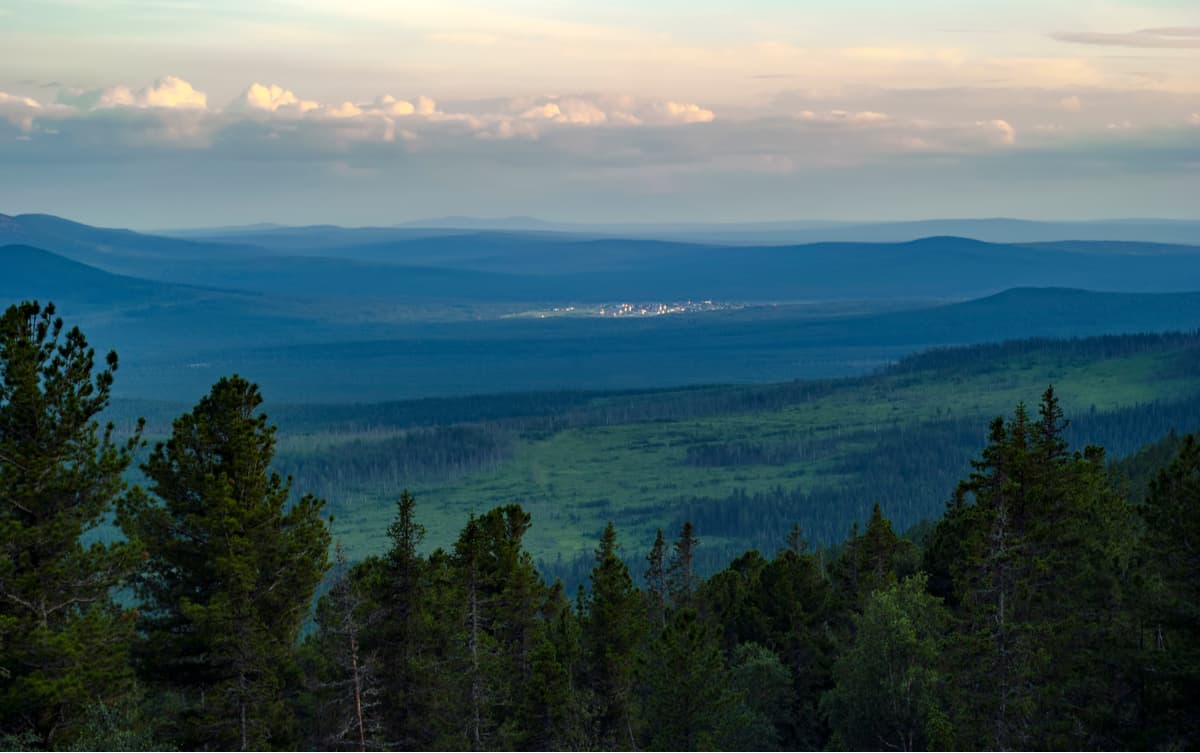
The relief of the region is diverse. The western part is mountainous, whereas the central and eastern parts are plain. The Main Urals Range extends from north to south. The highest point in the Sverdlovsk Region is Konzhakov Stone (1,569 m).
The vegetation is dominated by coniferous and mixed forests, mainly birch, pine, spruce, less often aspen and cedar, while in the extreme south-east there are some forest-steppes. Forests cover about 82.3% of the territory. Mountain slopes up to 600 m high are covered with dark coniferous northern taiga forests (spruce, fir, cedar). The mountains, passes, plateaus starting from the height of 800 m and higher are covered with rocky tundra.
The fauna of the Sverdlovsk Region is filled with typical forest representatives. There are 66 species of mammals, 6 species of reptiles, 9 species of amphibians, 228 species of birds, and 48 species of fish.
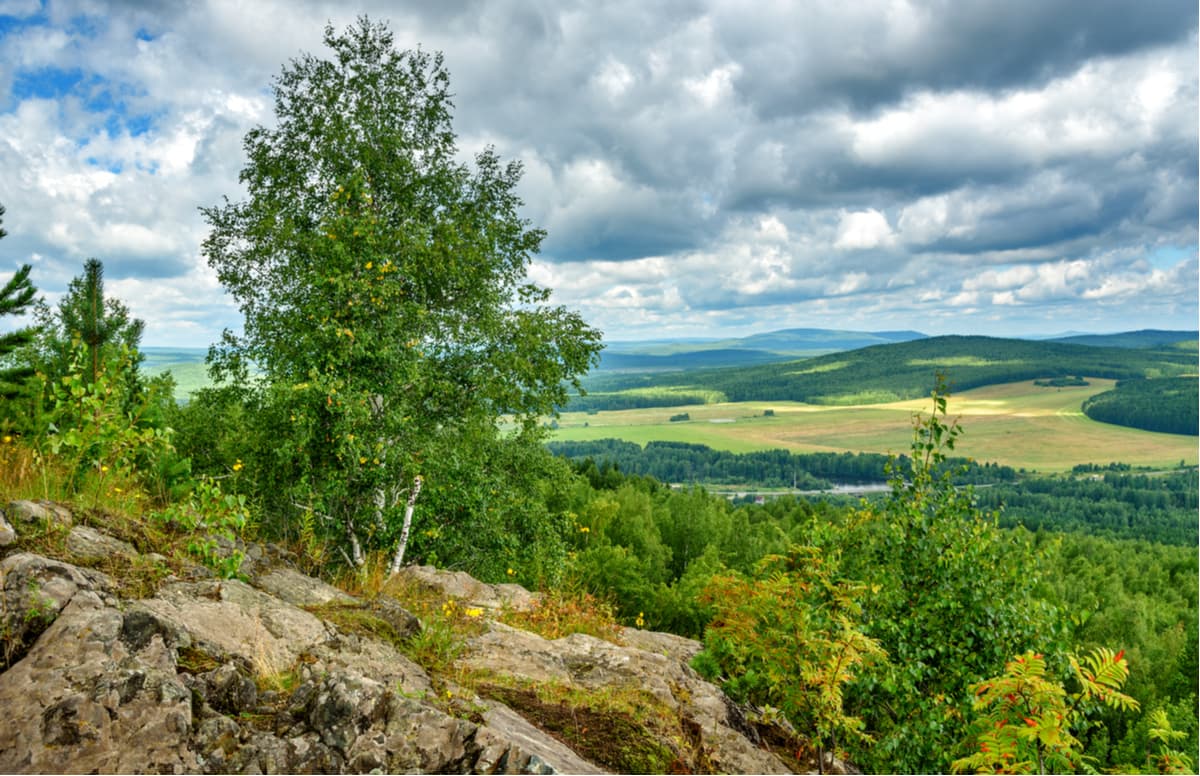
The watershed between the basins of the main tributaries of Russia's two largest rivers, the Irtysh and the Kama, runs along the ridges of the Ural Mountains and the eastern foothills in the south of the Sverdlovsk Region. The region's river network includes 18,414 rivers with a total length of more than 68,000 km. They are characterized by mixed feeding (by ground and meltwater, and atmospheric precipitation) with a predominance of snow (snow feeding is about 85-90% in the southern areas of the region and about 60-65% in the Ural Mountains ). The rivers freeze in late October-November and open up in April. The main river in the Irtysh basin is the Tobol with its tributaries of the first, second and third-order: the Iset, Tavda, and Tura (tributaries of the Tobol); the Nitsa, Pyshma, Tagil (tributaries of the Tura); the Lozva, Sosva, and Pelym (tributaries of the Tavda). The main rivers in the Kama basin are the Chusovaya River (a tributary of the Kama River) and its tributary – the Sylva River, and the Ufa River (a tributary of the Belaya River).
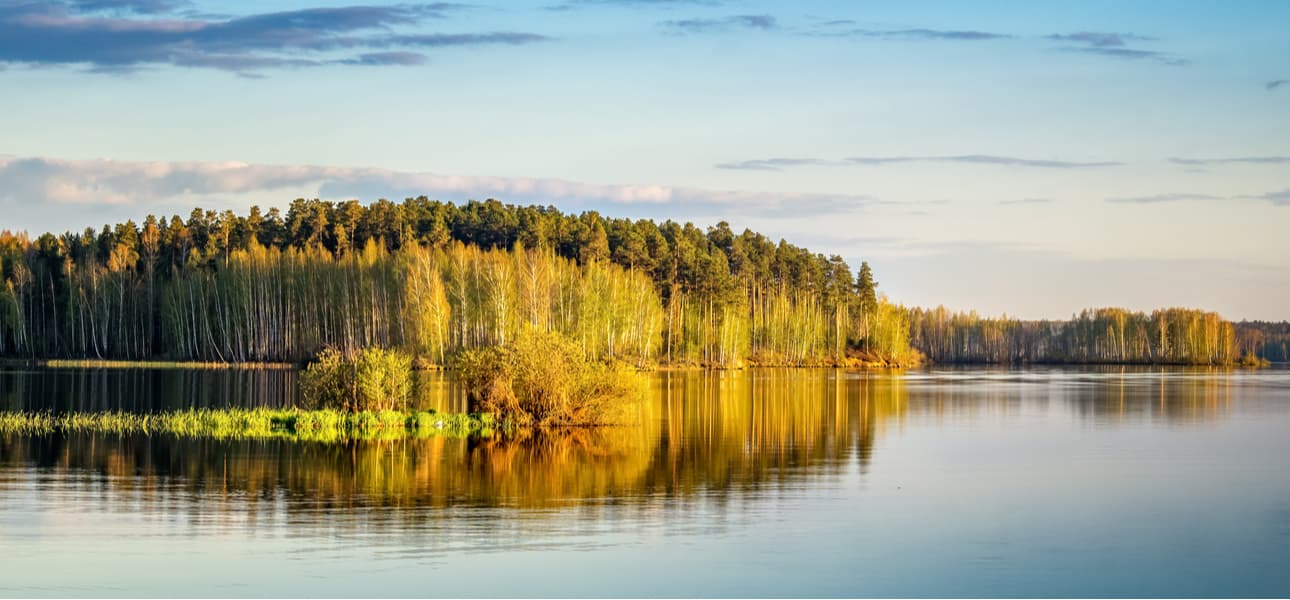
Swamps and marshlands occupy about 10.53% of the total area of the region (20461 sq. km.). The largest marshes are located in the north-east, in the Tavda river basin.
The Sverdlovsk Region has more than 5,850 lakes and artificial water bodies with the total area of about 1.35 thousand sq.km., including about 2000 lakes with the area of more than 0.01 sq.km, as well as a number of even smaller lakes (according to the Institute of Lake Science of the Russian Academy of Sciences).
The largest lakes in the region are the Pelymsky Tuman (its area is 65 sq.km) and the Vagilskiy Tuman (half the size of its bigger brother, it is 31.2 sq.km.). The largest artificial lakes are the Beloyarskoye reservoir on the Pyshma River and the Volchikhinskoye reservoir on the Chusovaya River. The Sverdlovsk Region takes the last place by the total area of lakes and artificial reservoirs, as well as by lakes among the regions of the Ural Federal District. The size and number of lakes, artificial reservoirs, swamps and wetlands is unstable and tends to change depending on natural factors such as water regime, climatic phenomena, swamping, etc. and anthropogenic factors, viz. excessive drainage or, conversely, watering of territories, regulation of river flows, etc.
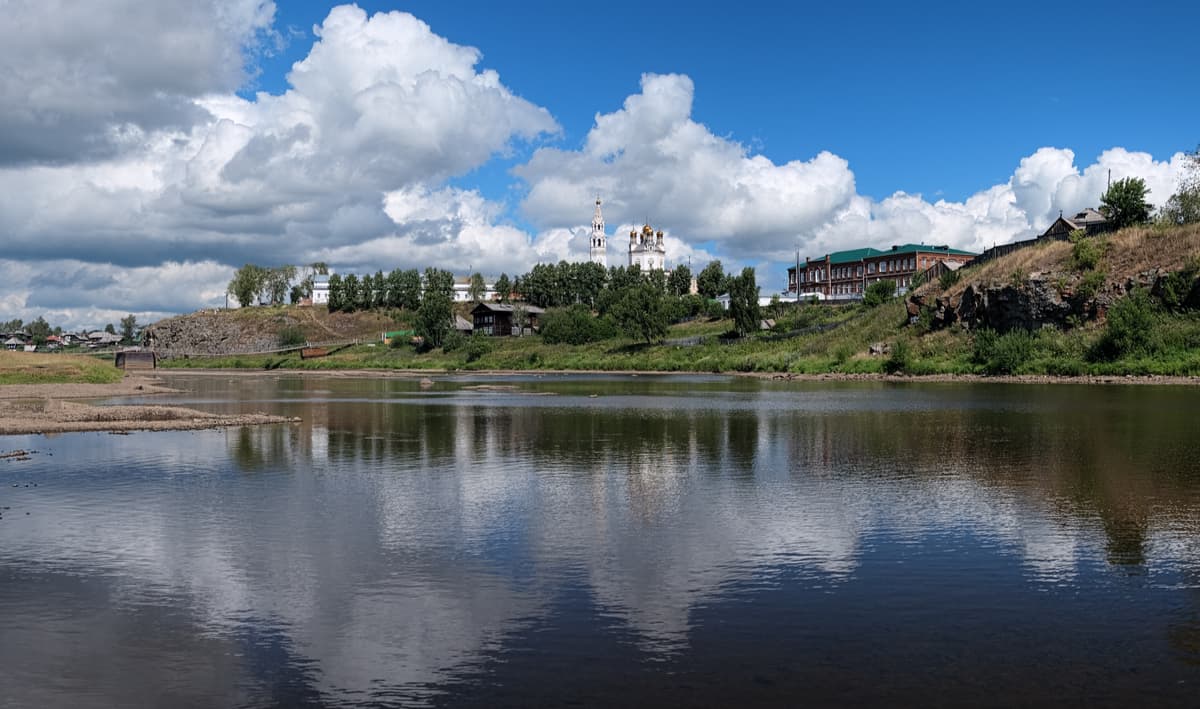
Underground water reservoirs are also powerful and aplenty in the Sverdlovsk region which ranks the third in terms of the volume of forecasted groundwater resources (after the Khanty-Mansi Autonomous Area and the Yamalo-Nenets Autonomous Area).
The climate of this area is moderately continental. The Ural Mountains partially protect the region from cyclones and anticyclones. Strong winds and snowstorms are quite rare. As we move away from the Main Ural Mountain Range and towards the south of the region, the air temperature increases and the amount of annual precipitation decreases. But on the whole, despite the large territory of the region, climatic conditions in all parts are quite similar. Seasons are well-pronounced, and precipitation is evenly distributed throughout the calendar year. Summer is warm, characterized by moderately hot weather without any extremes. The warmest month is July, with an average daily temperature of +21 to +26°C (+70 to +79 F), and in the mountains, it is only +14 to +16°C (+57 to +61 F). If you get very warm and dry air from Kazakhstan and Central Asia at this time of year, the daytime temperature can reach +35 to +40 ° C (+95 to +104 F), whereas the invasion of the Arctic air can bring some frosts at night frosts. Winter is freezing cold with dense snow cover. January is the coldest month of the year, with average daily temperatures ranging from -14 to -20°C (+7 to -4 F). However, during the Arctic cold air onslaughts, there are severe frosts down to -48 to -50 °C (-54 to -58 F), and in the northern parts of the region down to -55 °C (-67F). Thaws are also possible when the day temperature rises to +8°C (+46 F) in winter, but this is very rare.

The Sverdlovsk Region is one of the largest industrial centres in the country due to extensive mining. In terms of industrial output, it ranks second in Russia after the Moscow Region. There are rich deposits of bauxite, gold, various minerals, platinum and asbestos. The territory is blessed with many deposits of precious and semiprecious stones, they are mainly located in the so-called ‘gem strip’ running on the eastern slopes of the Ural Mountains .
There are many interesting places in the Sverdlovsk Region that attract travellers. In 2017, it was included in the top 10 most popular tourist regions of Russia. This area is especially suitable for aficionados of active rest.
Beautiful and majestic mountains attract herds of tourists in summer and winter alike. You can go hiking, skiing or drive snowmobiles here. The highest of the mountains are in the north of the Sverdlovsk region together with the main peak Konzhakov Stone (1,569 m). Tourists sometimes call the mountain Konzhak. The mountain is 450 km north of the city of Yekaterinburg. There is no cellular communication, but you can spend the night in a tent. Every year on the first Saturday of July, on the slopes of this mountain massif there is held an International Mountain Marathon Konzhak. It is a challenging 42-km distance running along the mountain trails and rock rivers of Konzhakov Stone , over the rivers and snows fields. The run goes from the river Konzhakovka to the top of the mountain and back.
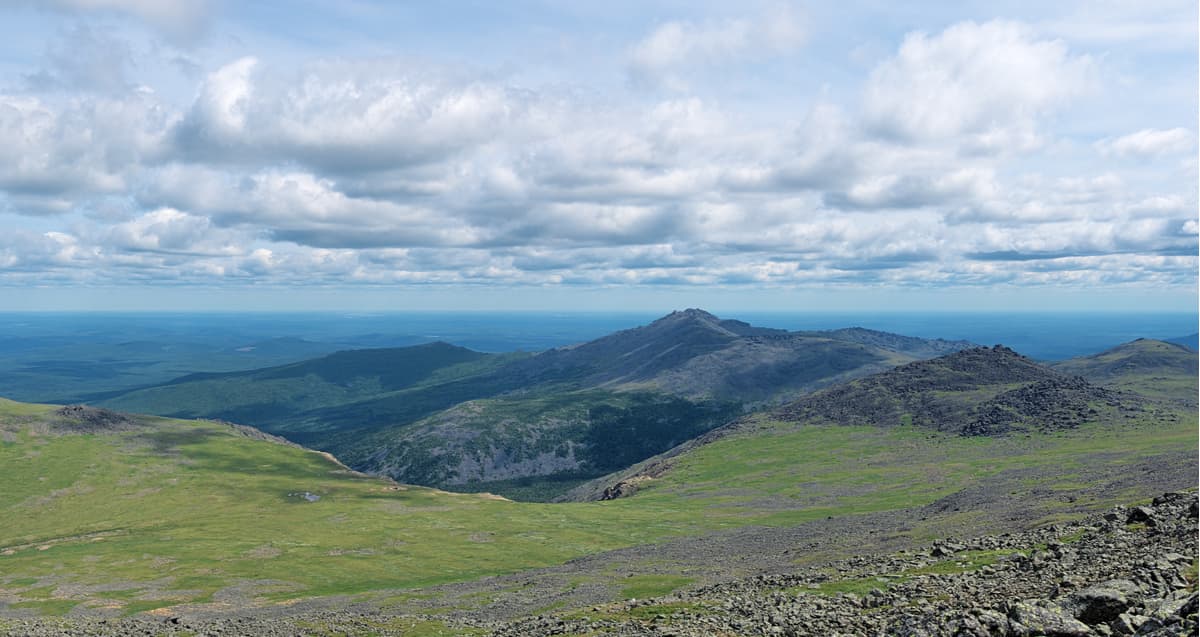
Next to Konzhakov Stone , in its eastern spur, there is Serebryansky Kamen Mountain (also called Serebryanka). The mountain is almost 300 m lower, but it is as frequently visited as Konzhak. The top of the mountain is crowned with huge and steep rock bastions. Its spurs are like the spine of a dragon. In winter, the mountain is often compared to the kingdom of the Snow Queen, so everything here is majestic and impregnable (rocks, ice and snow). On the slope of the mountain in the olden days there used to be a rescue base, the only remnant of that is a sauna. If necessary, you can stay there for a sleepover (it accommodates 3-4 people). The nearest connection with the Ministry of Emergency Situations is at the tourist base Serebryansky Kamen at the intersection of the highway Karpinsk-Kytlym with the river Serebryanka. Here you can spend the night, visit the bathhouse, there is a parking lot as well.
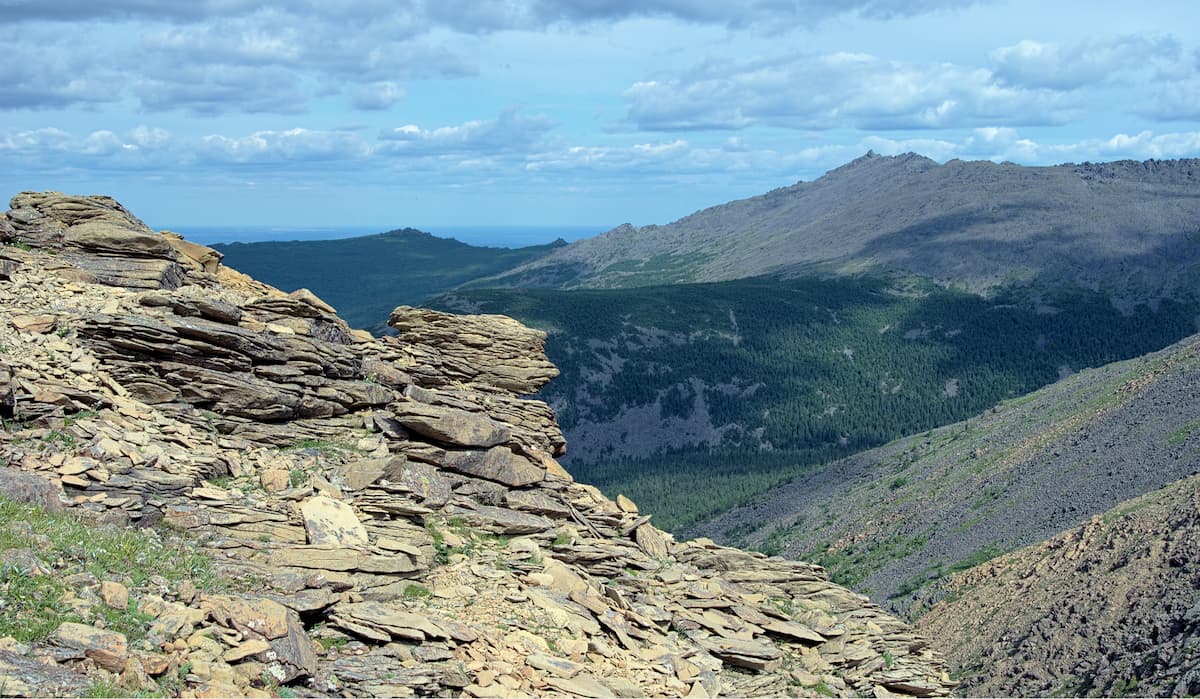
Other high mountain ranges include the Main Urals Range , the nearby Denezhkin Stone Range and the Kvarkush Range. Between the Main Ural Ridge and Denezhkin Stone Mountain there is the Zvezda camping site. There are also no cellular communications or regular transport links in the area. On the Kvarkush Range you can visit the Zhigalan Falls, a five-stage waterfall which is considered one of the most beautiful waterfalls in the Urals . By the end of autumn, the waterfall freezes, which attracts fans of ice climbing.
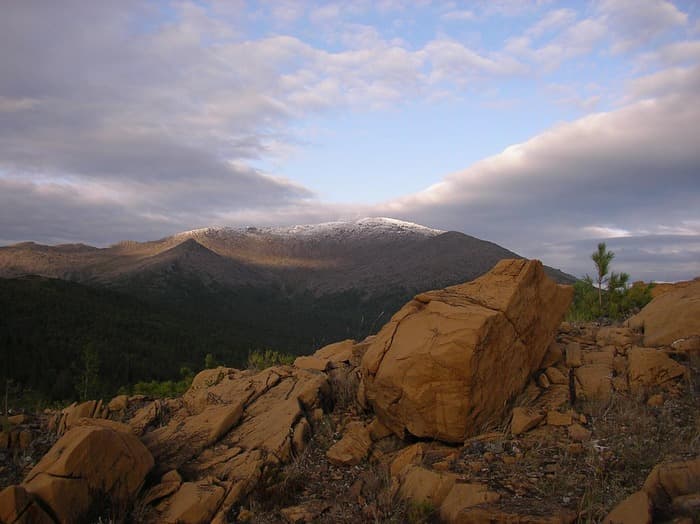
In the central and southern parts of the region, the mountains are low but easily accessible and no less beautiful. Among them are Mounts Kachkanar , Volchikha , Shunut , Sinyaya (Blue) , Azov-Mountain , and the Merry Mountains.
Kachkanar mountain is 270 km away from Yekaterinburg by the Serov road. It is a ridge with two peaks – Great Kachkanar (878 m) and Little Kachkanar (866 m). It is better to start climbing from the top of Mt Malaya. There was founded a monastery called Shad Tchup Ling (Place of practice and realization) on the northeast spur of this mountain in 1995 by Lama Sanje Tenzin Dokshitom (Mikhail Sannikov). When you come up to the beginning of the log path to the monastery, you are invited to take a brick with you up to the monastery so that your path would cease to be some common walking, but will gain the meaning. The bricks are needed for the construction of the site which is still underway today. There are several monks living on the mountain at any time of year. The guests are welcomed by the Awakening stupa. A stupa is a Buddhist commemorative monument usually housing sacred relics associated with the Buddha or other saintly persons. Another stupa is hidden in the rocks from prying eyes. Anyone can come to the monastery as a guest with an overnight stay or as a volunteer worker. From the monastery, the trail continues to Camel Rock, from where you can enjoy views of the town of Kachkanar and the huge steps of the Kachkanar Mining and Processing quarry (EVRAZ KGOK, formerly called KGOK Vanadiy, an iron ore producer). A small lake formed by flooding a quarry is located 500 m from the beginning of the trail to the monastery. From here, bypassing the monastery, there is another road to Camel Rock.
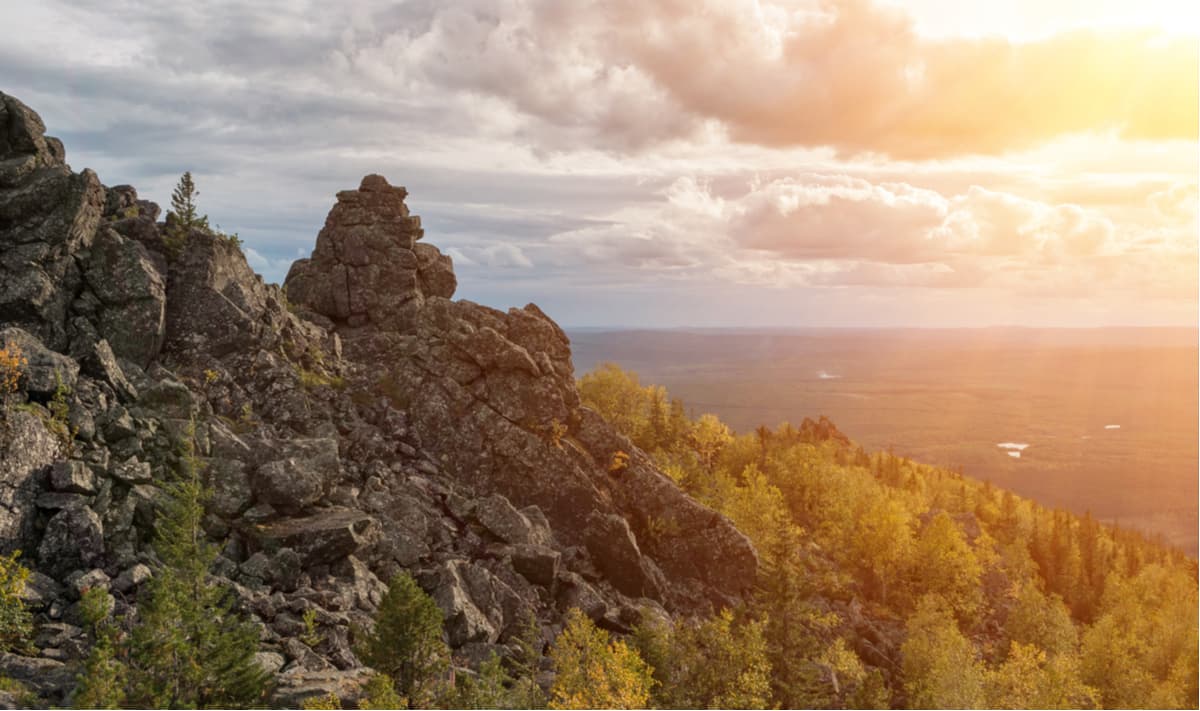
If you are pressed for time, within the city limits of Yekaterinburg there are beautiful rocks with bizarre forms, the most famous of them are the rocks of Peter Gronsky (aka Petrogrom or Grony), the Devil's Fortress, and the Seven Brothers. Tourists admire their beautiful views, and climbers train here to conquer the rocks of varying difficulty.
The rocks of Peter the Gronsky are stone remains on top of the Upper Iset granite massif (370 m high). The height of the rocks themselves is 15 m. They have several names. On the maps, they are called the rocks of Peter the Gronsky . In the Soviet times, it was believed that revolutionary workers headed by Peter Gronsky hid their weapons here and held mausoleums. However, local historians believe that Peter Gronsky, who lived at the Iset railway station in those years, could not participate in the revolutionary events, because he was still very young. Scientists call the rocks Petrogrom, in honour of Peter the Thunderer. They say that lightning strikes here very often. And among the tourists, there's a simpler name – Grony aka Thunderstorms. According to archaeological excavations, in ancient times there was a metallurgical production here, the ore was supplied here from the Sugra mine. Nowadays, it is a popular weekend route oftentimes taken with children at any time of year. From the rocks, there is a picturesque view of Lake Iset. The Petrogrom Rocks are located to the north-west of Yekaterinburg. You can get to them by public transport: by train to Nizhny Tagil, go 479 km to the station. The trail to the rocks starts on the right of the stop. A visit to the Petrogrom Rocks can be combined with a trip to the rocks of the Devil's Fortress and Iset Lake.
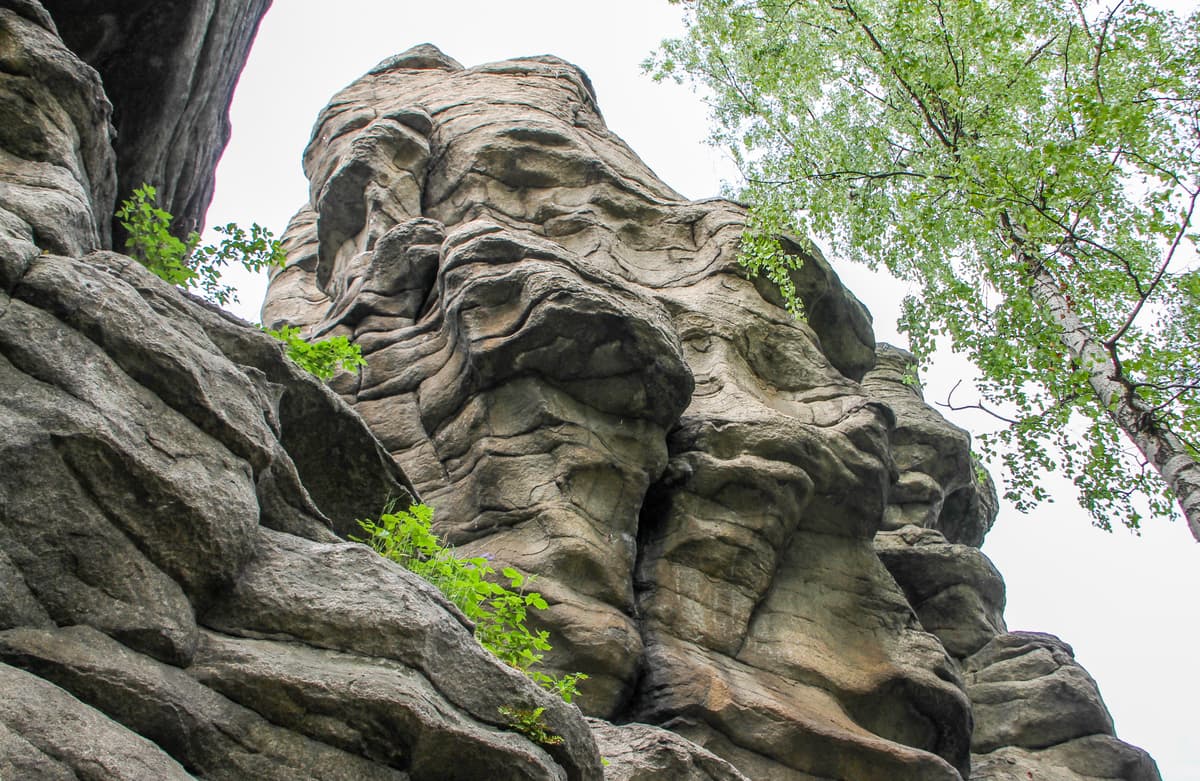
The Devil's Fortress is both a mountain (the absolute height is 347 m) and a rocky massif on its top. The rocks are a mighty granite ridge with a height of 20 m having a folded structure. As for the name, one version of the place was "damned or devilish" because if you look at such an erratic heap of granite slabs them seem so unnatural as if laid out by an evil force. In the process of excavations, there were found traces of ancient people staying here. Probably the first locals made sacrifices here to appease the gods. Mass visitation to the Devil's Fortress began at the end of 19th century after the Ural railway was opened. In 1980-1985, this place was closed to visitors. During this time the territory was cleared, garbage was taken out and the area was equipped with a climbing wall, one of the first in the USSR. For climbers, the northern side of the remains is of the greatest interest. The southern side is more gentle and goes down as if in steps to the valley of the Semipalatka river, a tributary of the Iset River. A wooden staircase leads to the very top of the Devil's Fortress. You can visit the Devil's Fortress by taking a train from Yekaterinburg to Iset station, the rocks are 6 km from this station.
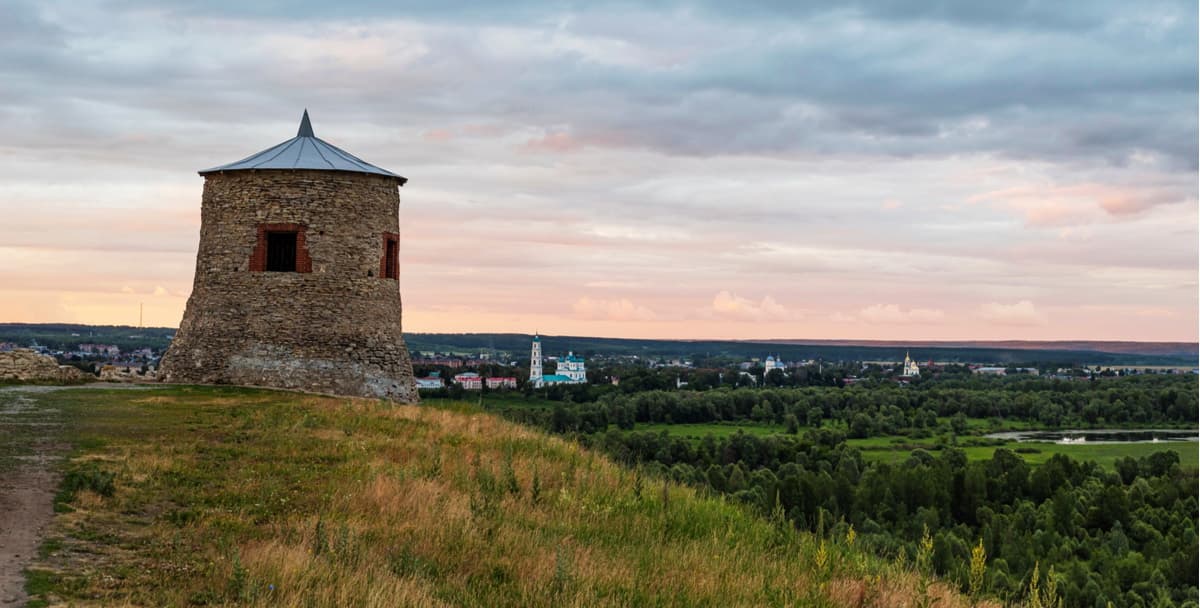
The Seven Brothers Rocks, one of the most popular rock idols in the Middle Urals , are the highest rocks in the vicinity of Yekaterinburg. They are located at the top of Mount Semibratskaya (422 m) and belong to the Upper Iset granite massif. The height of the idols is up to 32 m. In the upper part, the mount is dividing into separate stone columns of folded structure, reminiscent of giants or brothers, from which the name comes. Actually, there are more than seven ‘brothers’, and next to them there is a remnant called ‘a sister’. There are many legends associated with the name of the rocks, and most of them imply that the brothers turned into stone. No traces of ancient people were found here. It could be connected with the prohibition for ordinary people to visit this place because it was believed that gods lived there. Nowadays there are a lot of tourists here, climbers have the training and sometimes competitions. Nearby (1.5 km) are the Rocks of Three Sisters. There are indeed three stone idols of no more than 20 m high. It is easy to climb to the south side. On the north side, there is an interesting big grotto. You can get to the Seven Brothers from the town of Verkh-Neyvinsk (7 km) and to the village itself take a train from Yekaterinburg.

Mount Bunar (612 m), which is the highest in the vicinity of Verkh-Neyvinsk and Novouralsk, has the Bunar idols. There are no idols on the top itself, they are scattered all over the slopes of Mount Bunar . It is not easy to find them among the dense taiga filled with windbreak. There is a belief that there are 999 idols in these forests. You climb one of them, you open your eyes to the next one. By the way, real idols which were worshipped by the peoples who lived here in ancient times must remain hidden from curious eyes. Most of the tourists manage to find two rock sculptures which are called very dramatically: the First and the Second. Not far from Mount Bunar , there are mineral deposits. To the south of Mount Bunar on the Kamenka River, there is one of the few deposits of green garnet in the Urals - a diamond-like demantoid. In the east, in the environs of the former mountain, there is now the Zaplotny Stone quarry where they mine tourmalines, chlorites, sphenes, and radiated zeolite. It is better to start the trip to Mount Bunar from Belorechka settlement or from the railway station Neivo-Rudyanskaya.
The relief of the Urals Mountains made it possible to build many ski centres in the Sverdlovsk Oblast. The largest of them are located on Belaya, Volchikha, and Yezhovaya mountains. In the city of Nizhny Tagil on Mount Dolganaya there is a ski jump complex where international competitions are held.
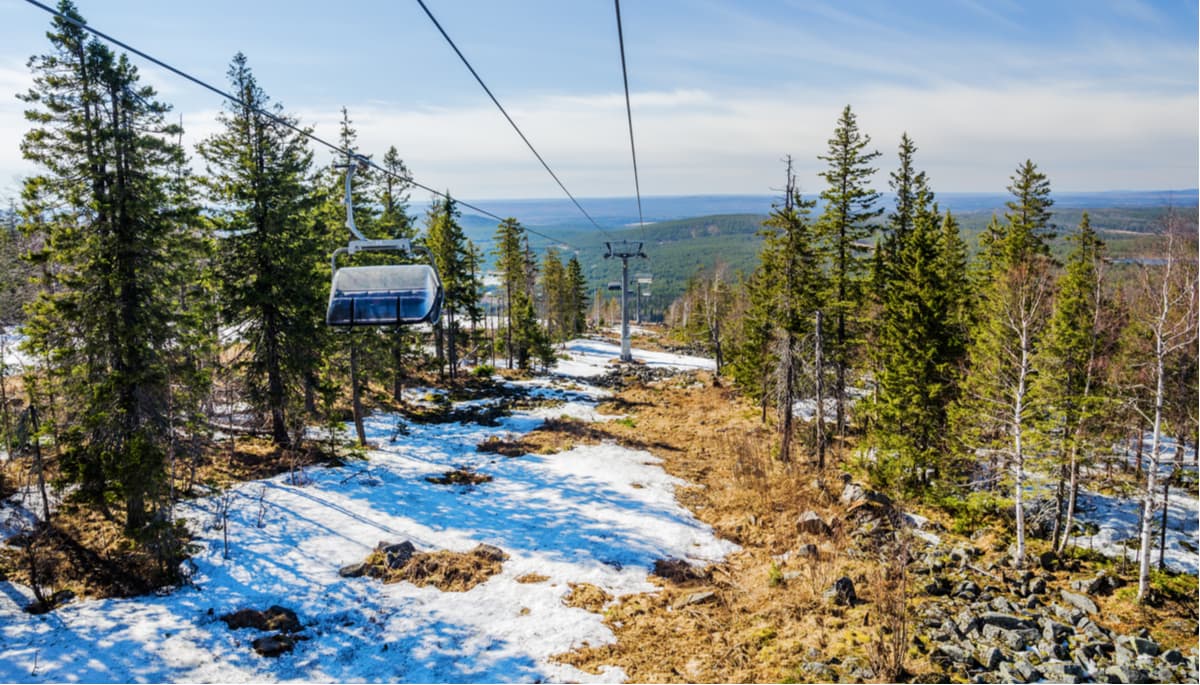
In the Sverdlovsk Region, you can see ethereal landscapes which the locals call the Urals Mars. Unusual beautiful landscapes reminiscent of Martian and sometimes lunar ones appeared on the place of former clay quarries. The official name of this place is Poldnevoy Section of the Troitsko-Baynovsky refractory clay deposit located south of the town of Bogdanovich, near the Poldnevoy village. The deposit is 20 km long and has an area of about 75 sq.km. It is one of the largest reserves in the Middle Urals. The clays have different colouring ranging from white and light grey to black with admixtures of iron oxides and humus matter. Due to this, the local clay quarries differ considerably in colour from each other. Clay hills have the appearance of ridges of different sizes. There are several lakes with water of orange and brown-red colour which is explained by the presence of pyrite in water. Bathing in such water is dangerous. Walking in this area can be likened to walking on another planet.
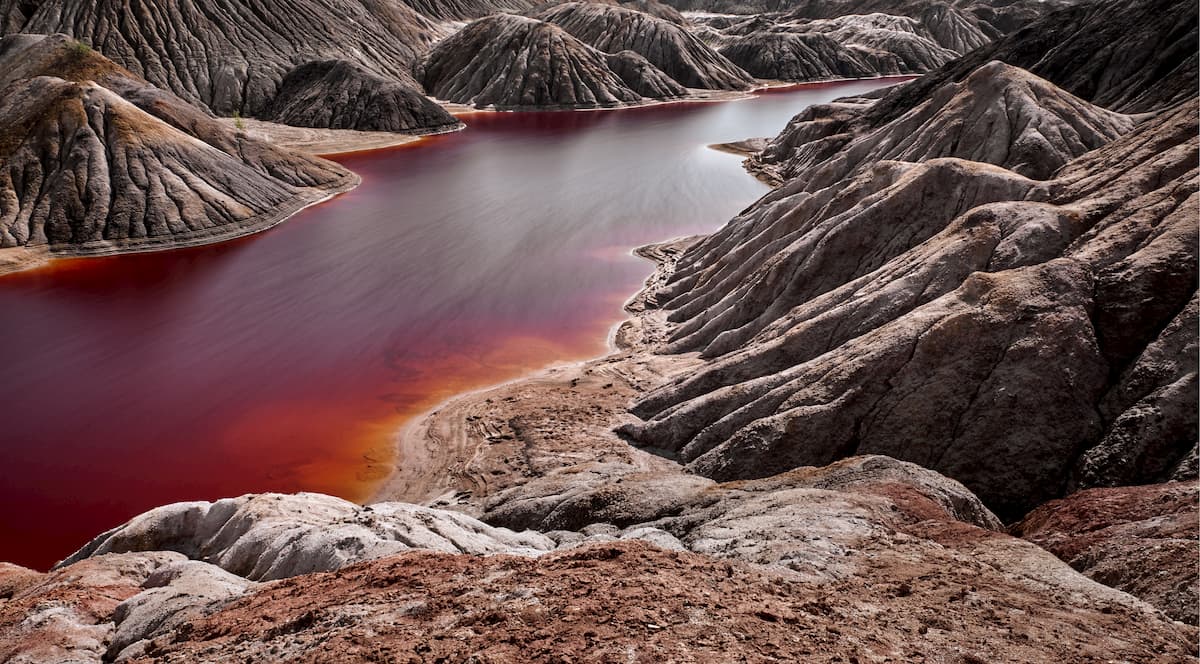
Thanks to karst phenomena, there are many caves, gaps, sinks, arches and other karst formations in the mountains. However, the exploration of grottoes and caves continues to this day and even geographers make very tentative guesses about their numbers. There are about 80 caves in the Sverdlovsk Region that are more than 50 meters long and deeper than two meters.
The longest caves are the Severnaya Cave (2,250 m long), the Bolshaya Yurtishenskaya Cave (930 m long), the Tayozhnaya Cave (850 m long), the Smolinskaya Cave (630 m long), and the Druzhba Cave (500 m long).
The deepest caves are the Sadykovskaya (88 m), the Tayozhnaya (64 m), the Saranskaya (49 m), the Vetrovaya (45 m), and the Volkovskaya Mine (44 m).
The most popular caves in the Sverdlovsk Region are the Smolinskaya, Druzhba, and the Arakayevskie caves. The Smolinskaya Cave is located two kilometres from the village of Beklenishcheva in the Sukholozhskoye District. The Druzhba Cave is located near the Iset River and the Revun rapids. The Arakayevskie caves can be found near the village of Arakayevo in the Deer Streams Nature Park.
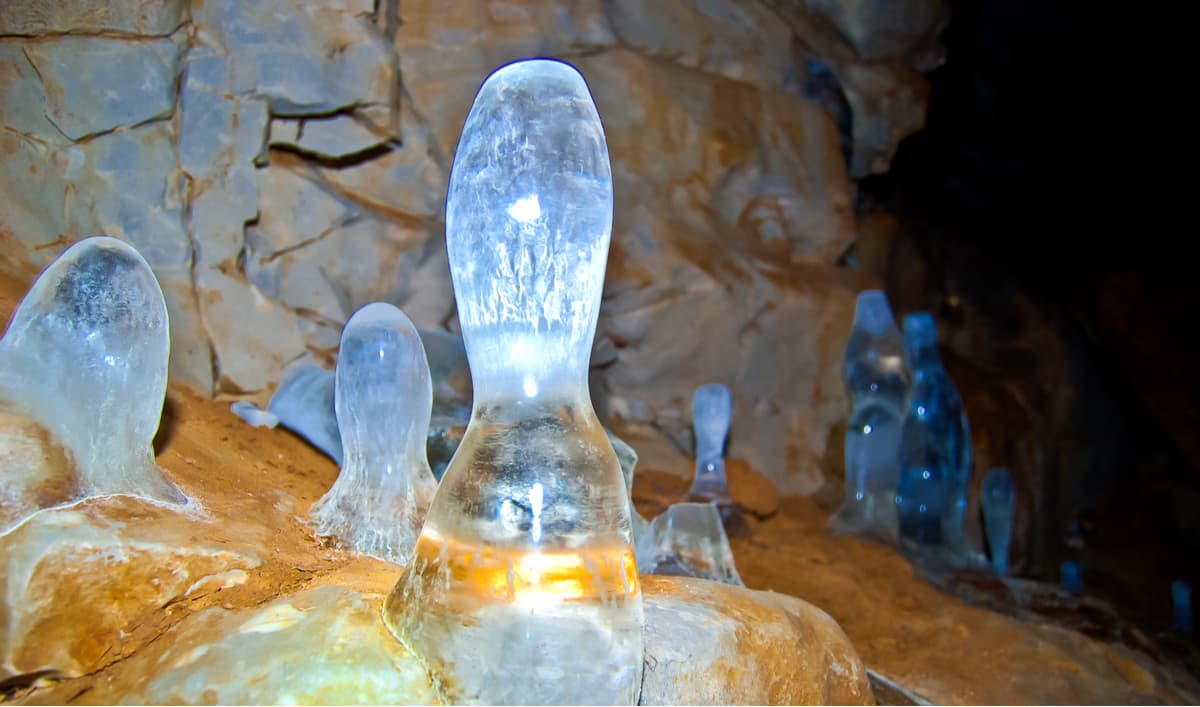
The Sverdlovsk region has many interesting places to visit:
- Nature reserves Denezhkin Stone , Visimsky
- Nature parks Deer Streams , Chusovaya River, Bazhov’s Places;
- National Park Pripyshminskie Pinewoods
- Nature and mineralogical reserve Rezhevskaya
Fans of water trips will be interested in rafting along the picturesque rivers Chusovaya, Sosva, Lozva, Serga, Iset, Rezh, Kakva, Ivdel, Tagil, Ufa, Neiva, Pyshma, Shishim, Serebryanka, Sulem, Ay, and Bardym. The most stunning of them is the Chusovaya River. On the banks of many rivers, there are plenty of beautiful rocks of various shapes and sizes.
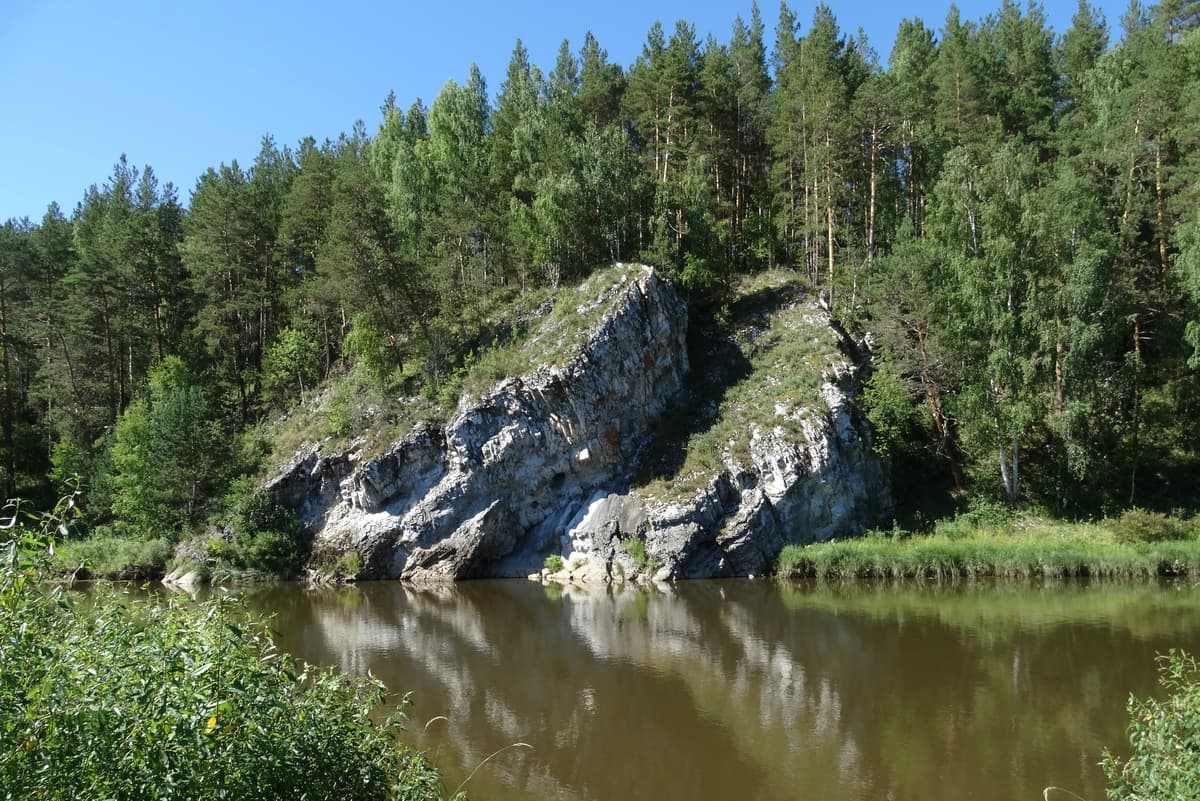
For the lovers of extreme pleasures, the Revun rapids on the Iset River are the biggest temptation. The Iset River is a calm, not a mountain river but for 500 m it turns into a bubbling stream and shows a duel of water and stone. The complexity category of the rapids varies depending on the season and water level in the river from the 2nd to the 5th at the end of March or in April during the flood. It is often possible to watch rafters' competitions or training sessions in canoes, catamarans, kayaks on the Revun rapids. Beklenishchevskie rocks (20-30 m high) surrounding the rapids lure all types of climbers, experienced and beginners alike. In 1989, the last All-Union Tourist Con was held here. In the vicinity of Revun, just 1.5 km away, there is the Smolinskaya cave (500 km downstream, on the opposite bank and 800 m deep into the forest to be exact), which can be visited after rafting.
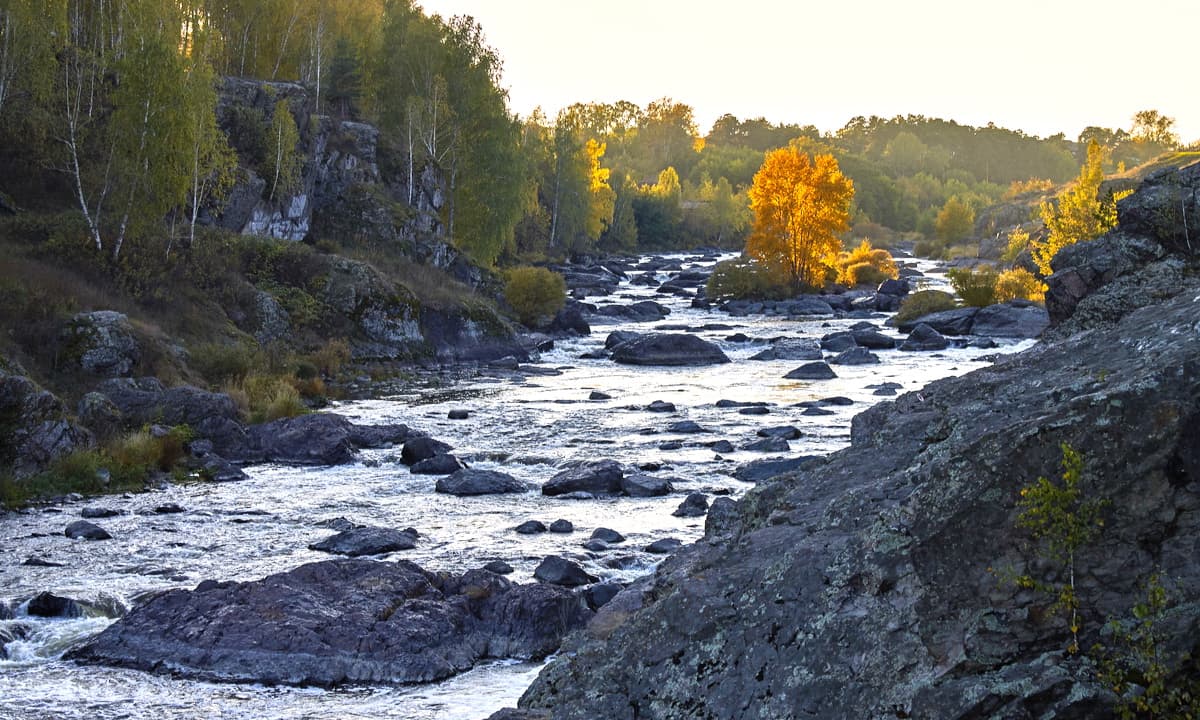
The following zoo nurseries are located in the Sverdlovsk Region:
- Maral farm Visimskiye Zori. Marals are large semi-wild deer brought here from the Altai. It is situated in Visim settlement, 180 km from Yekaterinburg.
- Zoo in Pridannikovo village, 200 km from Yekaterinburg.
- Irbit ostrich farm in the town of Irbit, 205 km from Yekaterinburg.
- The equestrian sports club Kapriol which keeps horses, reindeer, and white camel. You can order a tour, or go for a walk to the Seven Brothers Rocks. The club teaches horseback riding. It is located in Verkh-Neyvinsky, 70 km from Yekaterinburg.
- Deer reserve UZGA. It is situated not far from Itkul, near Sysertskoye Lake, 116 km from Yekaterinburg.
- Kholzan bird of prey nursery near the village of Kashino, 46 km from Yekaterinburg.
Those who want food for thought and a calmer but no less interesting experience should go to the major cities of the Sverdlovsk region where you can visit their temples and monasteries, museums, and get acquainted with local culture and traditions.
The main pearl among the cities of the Sverdlovsk region is its capital city – Yekaterinburg. You can get to Yekaterinburg in one of the following ways:
- Fly by plane to Koltsovo Airport.
- Take a train to the station of Yekaterinburg (Sverdlovsk-Sortirovochnaya station).
You can take a bus, suburban train or a taxi to other towns of the region from Yekaterinburg.
By order of Peter the Great, the city of Yekaterinburg, also spelt as Ekaterinburg, was originally established in the Urals as an industrial and trade centre. In 1723, the Yekaterinburg plant was built on the Iset River. This year is also considered the birthday of the city. Its founders are Vasily Tatishchev and Georg Wilhelm de Gennin. The city received its name in honour of the wife of Peter I, the future Empress Catherine I. The city has a favourable geographical location. Yekaterinburg is located on the eastern slope of the Ural Mountains , in the Middle Urals. The Ural Mountains in this place are low, they are basically hills, which provides favourable conditions for the construction of railways and large roads here. The Koltsovo International Airport is also located here. Now Yekaterinburg is one of the largest transport and logistics hubs. The city has many shopping and office centres. Yekaterinburg is the most compact city with a population of one million people in Russia. Its area is 490 sq. km. In terms of population (about 1.5 million people) it is the fourth city in Russia after Moscow, St. Petersburg, and Novosibirsk. The main river of the city is the Iset. There are also ponds within the city limits: the Urban, the Upper Iset, and the Lower Iset ponds. All the tributaries of the Iset in the city except the Patrushikha River were hidden underground in the past years. Yekaterinburg is the only city in the Urals with metro, and for a long time, it was considered the shortest in the world.
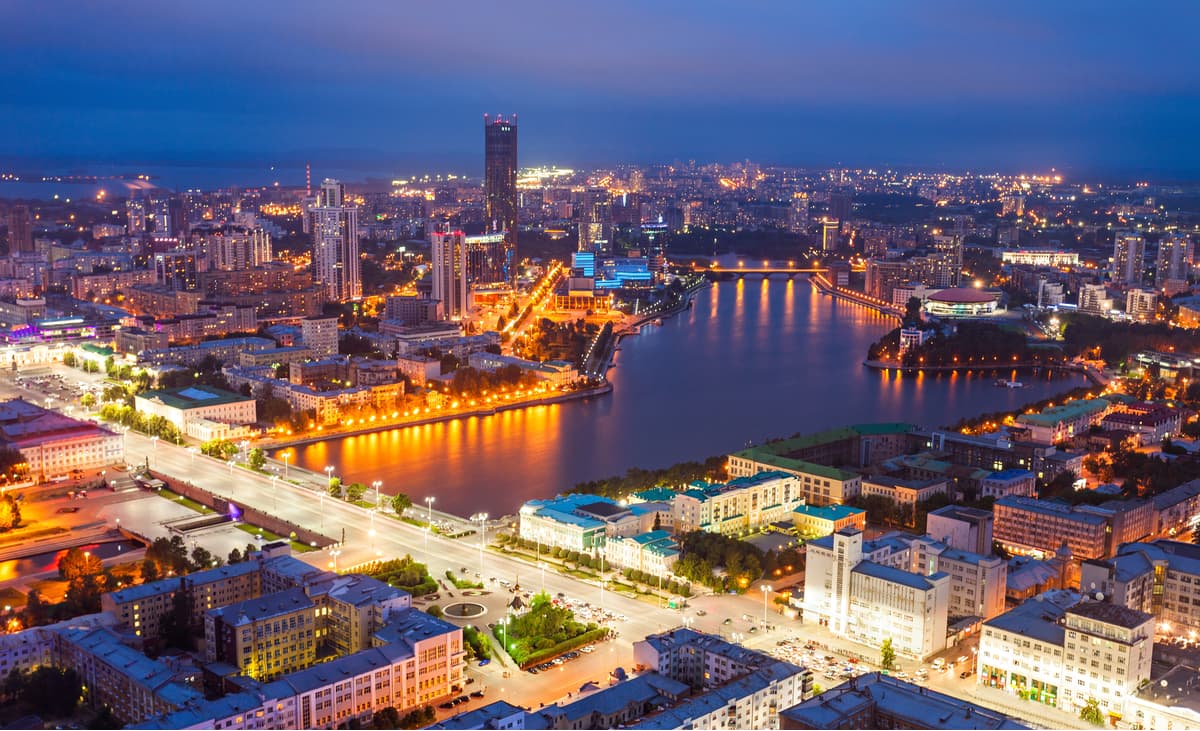
It is convenient to start a brief acquaintance with the history of the capital of the Urals with the Plotinka - the dam of the city pond that gave rise to the plant and the city of Yekaterinburg itself. A stone's throw from it, there is a monument to the founders of the city (Tatishchev and de Gennin), a chapel in honour of Catherine I and a fountain called the Stone Flower. In addition to the dam and the pond, you can visit the exhibition of large-size equipment of Ural factories in the open air. A walk along the embankment of the city pond and along the Iset River in the centre of the city will open views of the old buildings preserved here. In summer, you can take a boat ride on the pond.
Another attraction is the Temple on Blood built on the site of the Ipatyev’s house. It is believed that during the Civil War in 1918 in the basement of Ipatyev's house the last Russian Emperor Nicholas II and his family were executed. The cathedral was built in the Russian-Byzantine style and divided into the Lower and Upper Temples. There are a firing room and a small museum in the tomb chapel of the Lower Temple.
Across the road from the Temple on Blood, on Voznesenskaya Hill, there is a palace and a park which is sometimes called the Yekaterinburg Acropolis. The estate of the Ural Kharitonov-Rastorguyev dynasty includes a park with an artificial pond and a gazebo-rotunda on it.
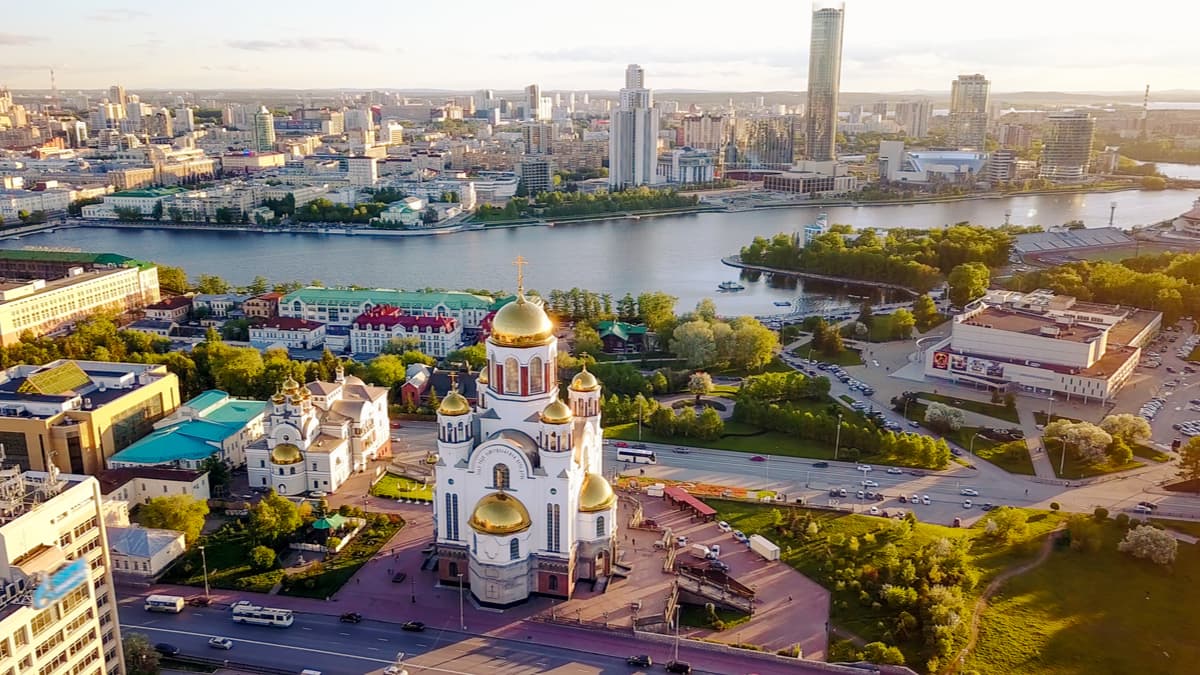
To get acquainted with the panorama of the city, it is worth visiting the observation deck of the skyscraper Vysotsky (the 52nd floor, height of the platform 186 m). There is also an observation deck in the business centre of Antey.
There are many theatres in Yekaterinburg, as well as a philharmonic, circus, zoo, and an aqua park. Museums are plenty as well, there is the Museum of History of Yekaterinburg, Museum of Ural History and Archaeology, Museum of Nature, Museum of Radio, Museum of Fine Arts. In addition, the museum complex is located in the Literary Quarter. In the Sverdlovsk Regional Museum of Local Lore, you can see the world's oldest wooden sculpture – the Big Shigir Idol, its age according to the latest estimates is 11.6 thousand years. The most modern museum in Yekaterinburg is Boris Yeltsin’s Museum located in Yeltsin centre. Yeltsin Center itself has become a large public, cultural and educational centre, which hosts many bright, interesting events in the city.
Among the natural sights within the city limits the most interesting are the rocks of Shartash stone tents and lake Shartash, and the Baran peninsula on Upper Iset pond.
Explore Sverdlovsk Oblast with the PeakVisor 3D Map and identify its summits .

PeakVisor Hiking Maps
Be a superhero of outdoor navigation with state-of-the-art 3D maps and mountain identification in the palm of your hand!
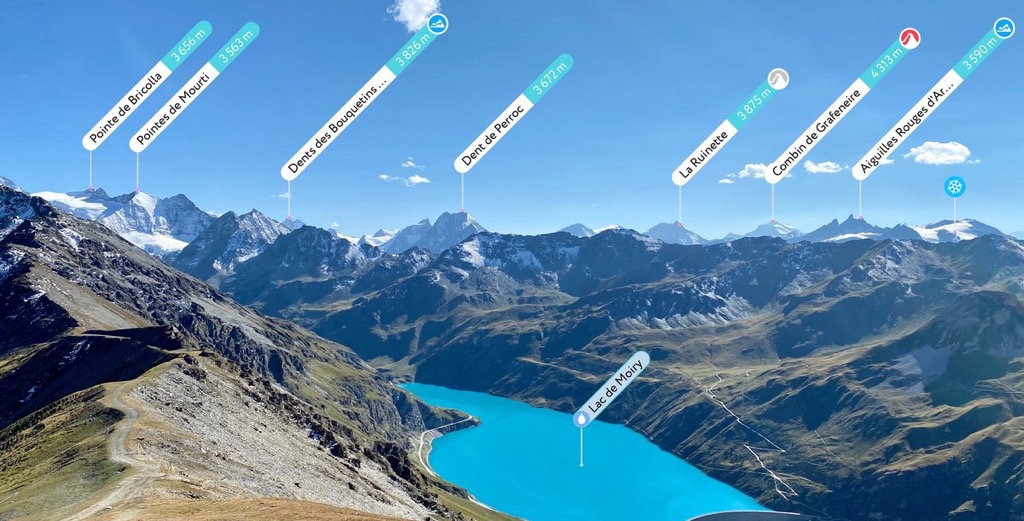

IMAGES
VIDEO
COMMENTS
Catamarans. Our ships. Adriana . Danica . Dora . Dubravka . Jelena . Judita . Karolina . Kata . Novalja . Olea . Silba . Vida . Jadrolinija. Riva 16, HR-51000 Rijeka ... 072 30 33 37. Call price from fixed network is 0,03 EUR/min. This is the official website of Jadrolinija. Jadrolinija guarantees the accuracy of the data only on its website ...
There are no difficulties in maritime traffic, all Jadrolinija ships are sailing according to schedule. News for passengers. 02.06.2024. 14:42. Notice for passengers traveling on lines with reservations. Ticket purchase and boarding on reserved lines. Jadrolinija. Riva 16, HR-51000 Rijeka;
Split - Hvar. A direct fast ship line departs from the ferry port of Split and connects the town of Hvar on the sunniest Croatian island of the same name. Hvar is an interesting destination for everyone - from rich history, nature, to nightlife. A purchased ticket also means a reservation of a place on the ship and departure at the desired time.
Jadrolinija. Jadrolinija is the main ferry company in Croatia. The company has more than 100 year long history. It is based in Rijeka, but operates from all four major ports in Croatia - Rijeka, Zadar, Split and Dubrovnik. In total the company has more than 50 car ferries, catamarans, fast ferries and ships in operation.
Jadrolinija is a ferry company, which links some cities crossing the Adriatic Sea, in the Croatian Coast. We go from Vela Luka (in Korcula Island) to Split (in mainland) and we did the journey at early.morning, so we could see.the sunrise surrounded by islands. Really very nice moments to take a lot of pictures.
Jadrolinija is a Croatian ferry company that connects most of the Croatian islands to the mainland by regular passenger and car ferry services along the ... conventional ships, catamarans and hydrofoils serving local routes along the Croatian coast. The popular coastal ferry route from Rijeka to Dubrovnik (via Split, Stari Grad-Hvar ...
The Jadrolinija catamaran has the following sailing route: Split - Bol - Hvar - Korčula - Dubrovnik. The sailing time is around 6 hours. The Krilo catamaran runs the following route: Split - Bol - Makarska - Korčula - Mljet - Dubrovnik and the travel time is about 5 hours.
Jadrolinija fleet & ships. Jadrolinija's fleet consists of 57 vessels: 12 high-speed ferries (catamarans), 4 conventional ferries, and 41 Ro/Ro vessels including the vessels Marko Polo and Dalmacija operating the international connections between Croatia and Italy. Some other Jadrolinija ferries are Jelena, Sveti Juraj, Lubenice, Karolina, and ...
Jadrolinija is the main and largest ferry operator in Croatia, operating the vast majority of the car ferry and catamaran routes in the country. Jadrolinija also operates a number of international ferries to Croatia (although these only exist from Italy to Croatia!). If you're planning on travelling down the coast or visiting any of the islands in Croatia, you will very likely be utilising ...
Jadrolinija. Jadrolinija is Croatia's national ferry company. Founded in 1947 to connect Croatia's islands with the mainland, Jadrolinija currently operates a fleet of 56 ships including 37 local ferries, 8 catamarans, 1 hydrobus and 5 regular ships. There are up to 500 daily departures in the summer, with about half that off-season.
Fast ferry (catamaran) Rijeka - Rab - Novalja (Pag), Jadrolinija, 9309 - timetable and prices for year 2024. Search and compare all ferries in Croatia.
FERRY TIP: One of the best ferries sailing the Adriatic is Jadrolinija's 100m-long Korčula, completed in 2017 with a capacity of 700 passengers and 170 vehicles. Its hour-long route starts at Split, and heads to the islands of Korčula and Lastovo at a speed of 16 knots (about 30km/h). The catamaran Vida, which also operates in the Split ...
Ship. Jelena. The catamaran was built in 2018 in Singapore for the needs of our fleet. It is characterized by the most modern water purification system, the most modern navigation system, and is fully adapted to people with disabilities, so we can say that it is one of the best boats of its type in the Adriatic.
Catamaran. Review of Jadrolinija. Reviewed June 8, 2022 via mobile. Tickets were purchased online. The ferry from split to hvar is quick and departs in a timely manner. Can get crowded so it's best to get there early to get the best seat. Date of experience: June 2022. Ask shenika c about Jadrolinija.
Catamaran 'Jelena' owned by Jadrolinija ferry company - A fast ferry from Dubrovnik via Korcula, Hvar, Bol on Brac island to Split. This is a daily summer ro...
Does anyone know if there is much difference between Krilo and Jadrolinija catamarans, comfort wise? Is there a big difference in travel time between catamarans and ferries? Should we purchase tickets on line before we leave. I understand the faster catamarans do not have open decks and 4 plus hours inside a closed cabin sounds like a long time.
Jadrolinija is a Croatian shipping company. ... In April 2023, a tender was announced for the purchase of two catamarans, for which Jadrolinija is ready to pay up to 14 million euros without VAT. The condition for these ships is that they must be up to 5 years old, up to 40 meters long and up to 12 meters wide, each with a capacity of at least ...
Sailing Time: About 5 hours (Krilo) and 6 hours (Jadrolinija) Departure Time: 15:15 from Dubrovnik. Arrival Time: 20:30 in Split. Operational Period: From April to October, daily service. Price: Approximately 45 EUR per passenger. Ferry Route: Split - Milna (Brač) - Hvar town - Korčula - Pomena (Mljet) - Dubrovnik.
Fast ferry (catamaran) Split - Hvar, Jadrolinija, 9604s - timetable and prices for year 2024. Search and compare all ferries in Croatia.
Among the natural sights within the city limits the most interesting are the rocks of Shartash stone tents and lake Shartash, and the Baran peninsula on Upper Iset pond. Explore Sverdlovsk Oblast with the PeakVisor 3D Map and identify its summits. 1 569 m 1 209 m. 1 519 m 829 m. 1 492 m 988 m.
Answer 1 of 4: Hi Friends, Finally I will be getiing to Yekaterinburg. I would like to buy some nice vodka and some nice caviar, any advice about what to buy and where to buy it? Thanks in advance Peter
Answer 1 of 5: Hi, my name is Pier , I`m going to visit Yekaterinburg the end of febraury. I´d like to kow if any of you has used UralTerra.com to book and pay online a flat or a hotel room. How was the service of uralterra one in Yekaterinburg? Can I trust...
Ministry of International and Foreign Economic Relations of the Sverdlovsk Region. Аddress: 620075, 21/23, Gor'kogo st., Yekaterinburg Postal address: 620031,1, Oktyabr'skaya sq., Yekaterinburg